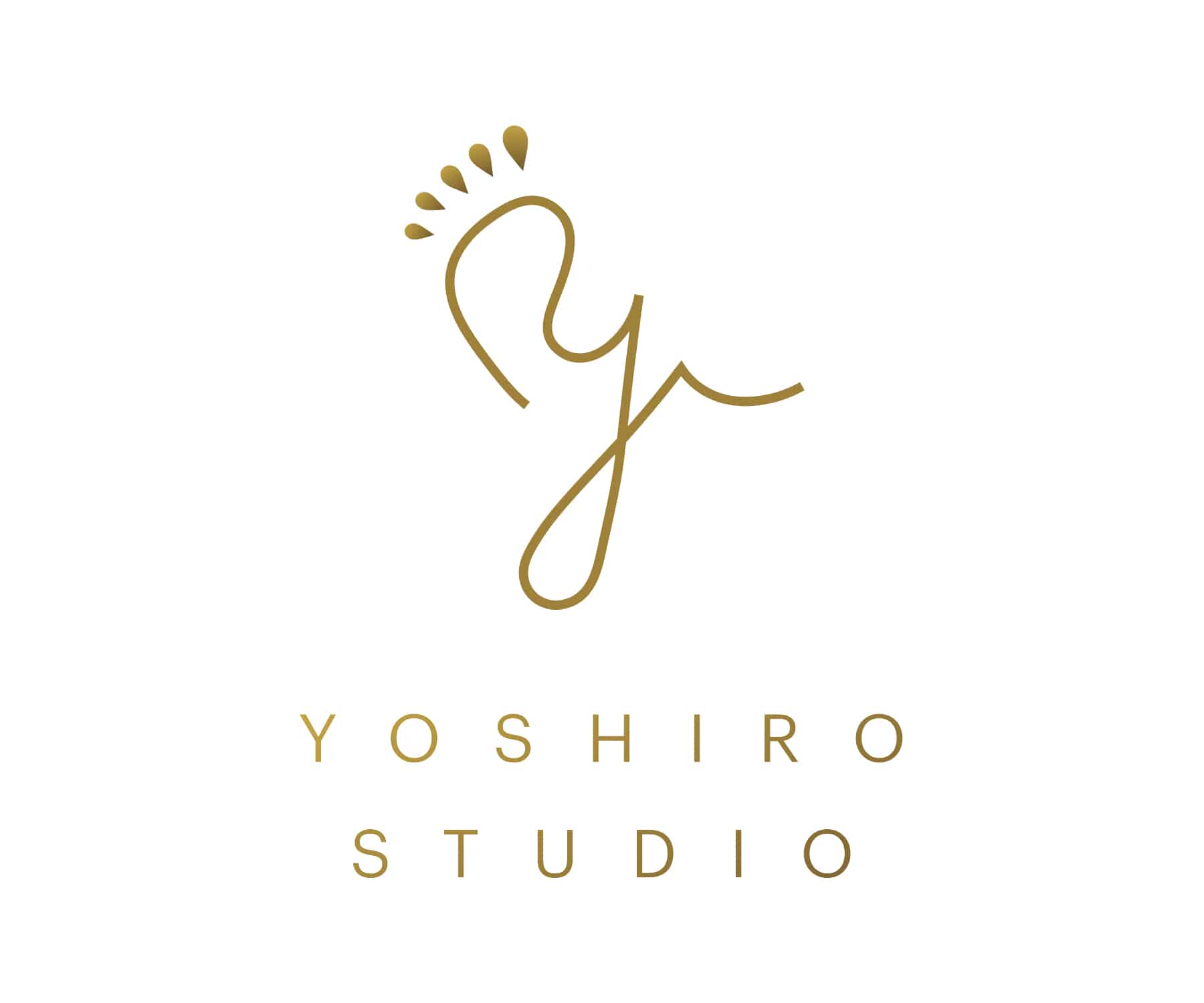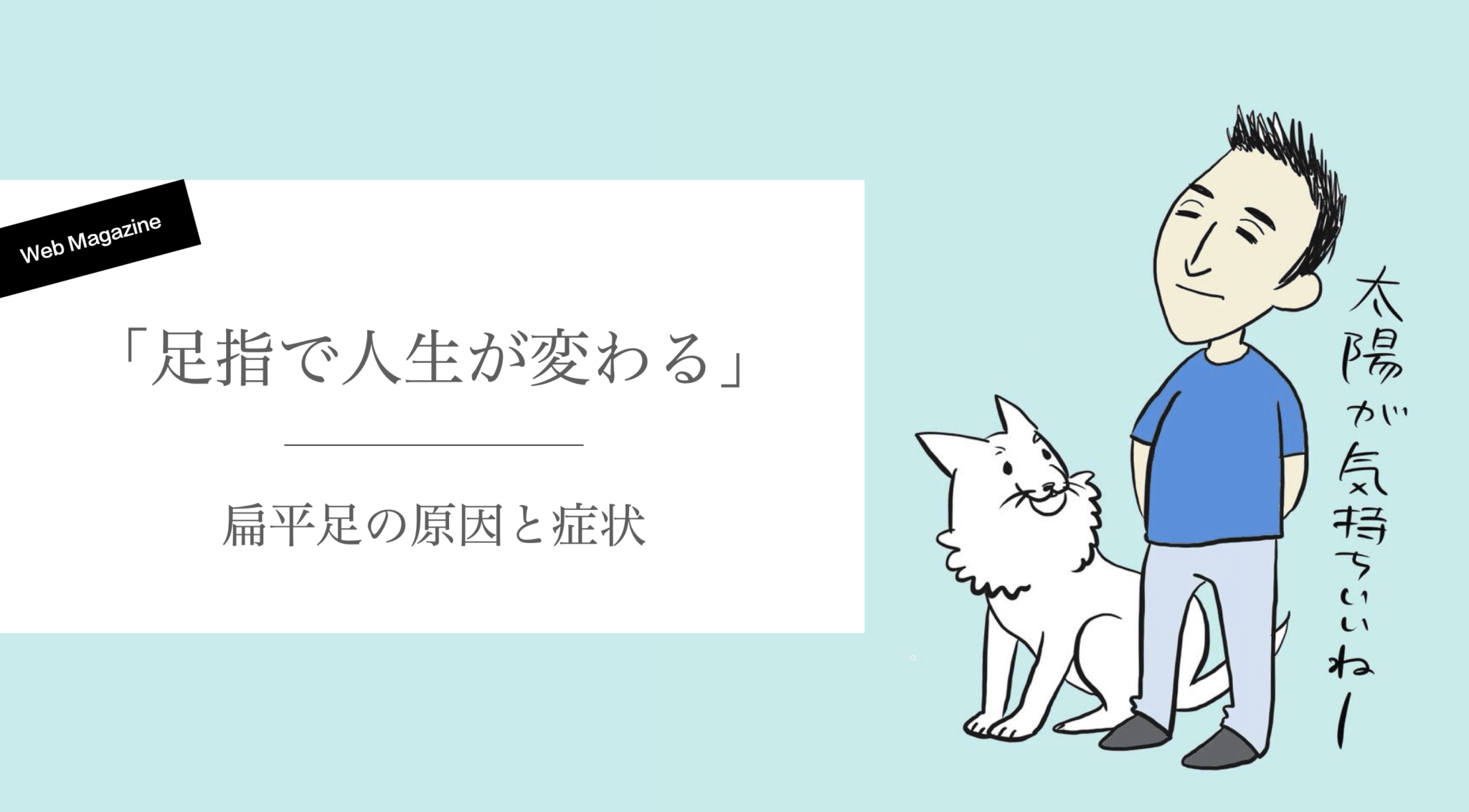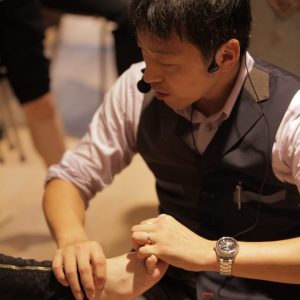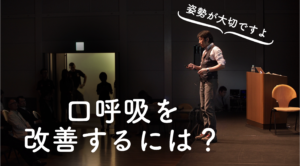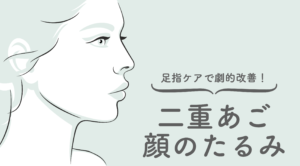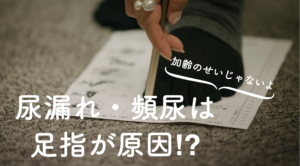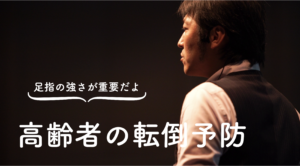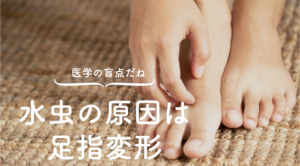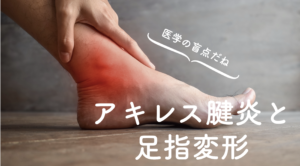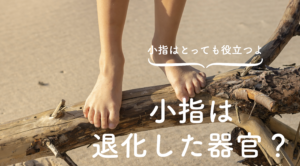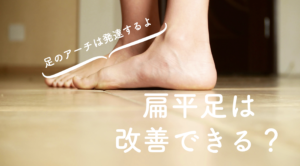What is flatfoot?
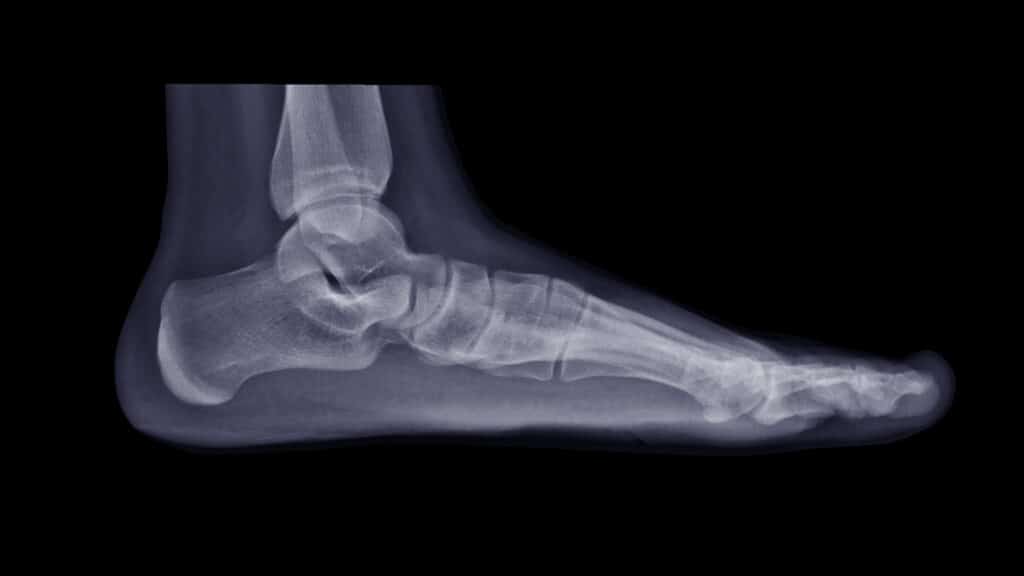
Flat feet, also called flat feet, are a condition in which one or both feet have little or no arch.is said to be the most important part of the foot. When you stand, the soles of your feet press against the ground. Normally, the arches of the feet are not visible, but they may appear when the feet are lifted. All babies are born with flat feet. The arches usually form by age 6, and about 2 out of 10 children remain flat-footed into adulthood. Flat feet are not a problem for most people. If flat feet cause pain or other problems, proper treatment can help. In some cases, children may be born with flat feet (congenital).
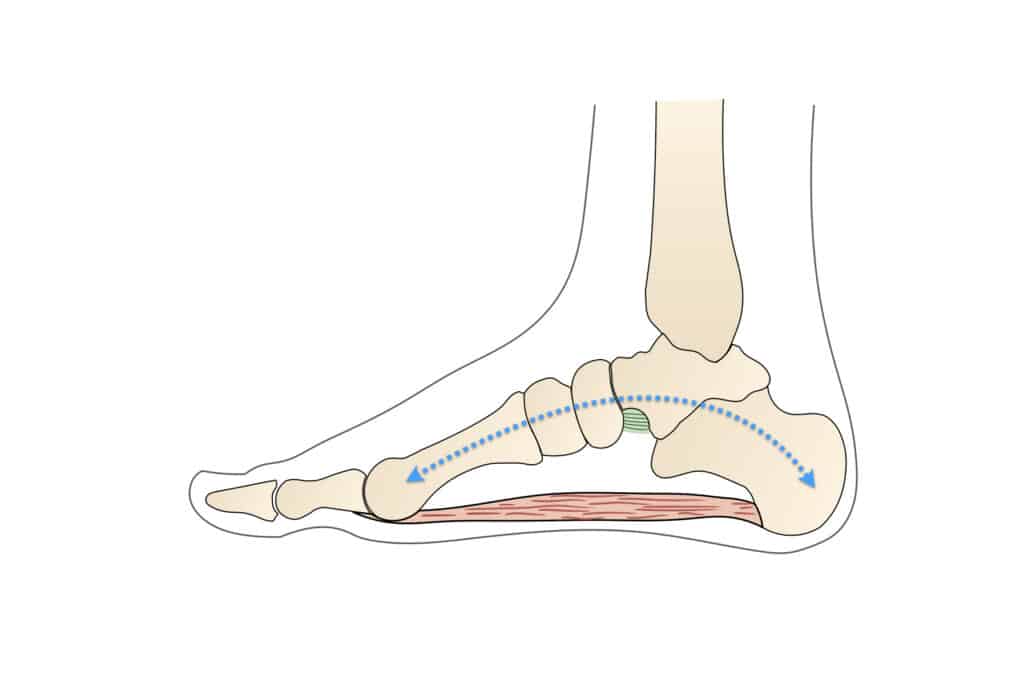

Research shows that flat feet are common in children and adolescents. Human arches develop during infancy and early childhood as part of normal muscle, tendon, ligament, and bone growth. Flat arches in children usually become higher arches as the child progresses through adolescence and into adulthood. Children with flat feet are at increased risk of developing knee, hip, and back pain, and a 2007 randomized controlled trial found no reliable data showing that treatment of flat feet in children with hospital-prescribed orthotics (such as shoe insoles) or over-the-counter orthotics is scientifically "effective" The results of the study were not. In other words,It means that the treatment itself in the hospital or clinic has no effect on improvement. As a symptom itself, flatfoot is usually associated with a genetic musculoskeletal disorder such as dyskinesia, laxity of ligaments, or hypermobility.
There is a functional relationship between the structure of the foot arch and the biomechanics of the lower leg; the arch provides an elastic and resilient connection between the forefoot and hindfoot so that the majority of the force applied when weight is applied to the foot is distributed before that force reaches the long bones of the leg and thigh. In flat feet, the head of the talus is displaced medially and distally from the navicular bone.
As a result, the plantar calcaneofibular ligament (spring ligament) and the tendons of the tibialis posterior muscle are stretched, and the flatfoot patient loses function of the medial longitudinal arch (MLA). if the MLA is not present or functional in both sitting and standing positions, the person has a "rigidity= The person suffers from "stiff" flat feet. If the MLA is present and functioning when sitting or standing on the toes, but this arch disappears when the foot is in a flattened position, the person has a "flexibility(katotropic) = "soft" flat feet. This latter condition is often treated with arch supports.
What are the different types of flat feet?
Flat feet can cause problems whether they persist beyond childhood or develop in adulthood. There are several types of flat feet, including
flexibility(in Japanese history)flexibility(walking with) one's feet flat (as opposed to sitting on the ground)
Flexible flat feet are common in children. In flexible flat feet,Feet have normal arches at rest (when not standing or walking)but the arch disappears when the foot makes contact with the ground while supporting weight. Flexible flat feet in children are caused by lax ligaments, excess tissue in the foot, or fat bodies in the sole, causing the arch to flatten without any detectable abnormalities in the bones or joints of the foot. Flexible flat feet may heal spontaneously, especially if they grow without treatment. Flexible flat feet are most common. It may gradually worsen with age, and the tendons and ligaments of the feet may stretch, tear, or swell.
hallux rigidus
Stiff or true flatfoot is caused by congenital bone or joint deformities of the foot, resulting in limited range of motion, decreased mobility, and weight bearing.Characterized by lack of arch even at rest, unlike flexible flat feetIt is. A complete lack of arches in the feet often results in foot pain, especially in the heel and the ball of the foot. People with rigid flat feet have no arch when standing (weight on the feet) or sitting (no weight on the feet). This condition often develops in the teenage years and worsens with age. The feet may feel painful. Bending the foot up and down or moving it from side to side may be difficult. Flat feet may affect one or both feet.
Adult Acquired Flatfoot
In adult acquired flat feet, the arches of the feet drop or collapse unexpectedly. When the arch collapses, the foot may turn outward and cause pain. This problem can affect only one foot. The most common cause is inflammation or rupture of the tendon (tibialis posterior tendon) in the leg that supports the arch.
Tendon dysfunction and degeneration: Injury to the tendons that support the arch (e.g., inflammation or rupture of tendons) can cause arch collapse.
Inflammatory arthritis: Rheumatoid arthritis can cause painful flat feet that attack the cartilage in the joints as well as the ligaments that support the feet.
Other causes include muscle imbalances that cause joints to be out of alignment, and conditions or damage to ligaments in the foot.
congenital vertical talus
Some babies have a congenital anomaly (birth defect) called vertical talus,Disease in which the feet are born with a protruding sole (navicular deformity)and prevents the formation of arches, resulting in flat feet.
Symptoms and Causes of Flatfoot
symptoms
In the early stages of flatfoot, most patients do not show any associated signs or symptoms. However, some flatfoot patients experience foot pain after walking or standing for long periods of time, especially in the heel and sole areas. If the condition progresses severely without proper treatment, swelling may occur on the inside of the foot and ankle, and other symptoms include the following
- Foot pain that occurs on the inside of the ball of the foot or in the heel, despite wearing comfortable or healthy shoes
- Swelling of the inside of the heel or ankle, or inflammation of the ligaments and tendons around the ankle
- Impaired balance or difficulty walking, standing on tiptoes, or climbing stairs
- Numbness of the feet, toe fatigue, or significant deformity
- Leg Cramps
- Muscle pain (soreness or fatigue) in the foot or leg
- Pain in the ball of the foot, ankle, heel, or outside of the foot
- Pain when walking and change in walking style (gait)
What causes increased risk of flat feet?
Even people who do not have flat feet may develop this condition. After injury, the arch may collapse suddenly. Alternatively, collapse may occur due to years of wear and tear. With age, the tendons that run along the inside of the ankle and support the arch may weaken or tear. With increasing severity, arthritis may develop in the foot. The risk of flat feet is also increased by certain problems, such as
Obesity
Foot or ankle injury
Rheumatoid arthritis
Aging
Diabetes mellitus
Achilles tendon injury
Fracture
Cerebral palsy
Down Syndrome
Pregnancy
Thus, flat feet can be caused by injury, disease, abnormalities to the foot orMay develop in adulthood due to long-term stress, biomechanical defects, or part of the normal aging process ("adult acquired flat feet"). This is most common in women over the age of 40. Known risk factors include obesity, hypertension, and diabetes. Flat feet are,May occur in pregnant women as a result of temporary changes due to increased elastin (elasticity) during pregnancy. If developed by adulthood, flat feet usually remain permanently flat.
If a young person or adult appears flat-footed when standing with full weight on the foot, but an arch appears when bottom bending or pulling the toes back with the rest of the foot flat on the floor, this condition is called flexible flatfoot. This is not a true collapsed arch because the medial longitudinal arch is still present and the wind-up mechanism is still operating. This condition is actually due to excessive turning of the foot (inward rotation). Strength training of the toes can help, and the height of the arch can be increased regardless of age.
cause
In a word, "toe deformity" and "toe malfunction" resulting in foot muscle weaknessIt is. Flat feet are not uncommon in infants and young children because the arches of the feet have not yet developed due to muscle weakness in the foot. Most people's arches develop throughout childhood, but if they grow up without the use of their toes, some people do not develop arches at all in adulthood. Some people with no arches may have problems, while others may not. Some children have flexible flat feet, called flexible flat feet, in which the arch is not visible when the child is sitting or standing on tiptoe, although the arch is visible when the child stands. Most children overcome flexible flat feet without problems.
mechanism
1. Flat feet due to weakness of foot muscles
Flat feet have a collapse of the medial arch, but many foot muscles support each other to keep the arch from collapsing. Viewed from the side,Three muscles, the tibialis anterior, tibialis posterior, and flexor digitorum longus, form the archThe bones that do this are lifted.posterior tibial tendonis positioned below the ligament, dynamically supporting the head of the talus and suspending the arch from above. This isflexor digitorum longusIt is the largest and most powerful muscle for supporting the medial longitudinal arch, also supported by the tendons of the
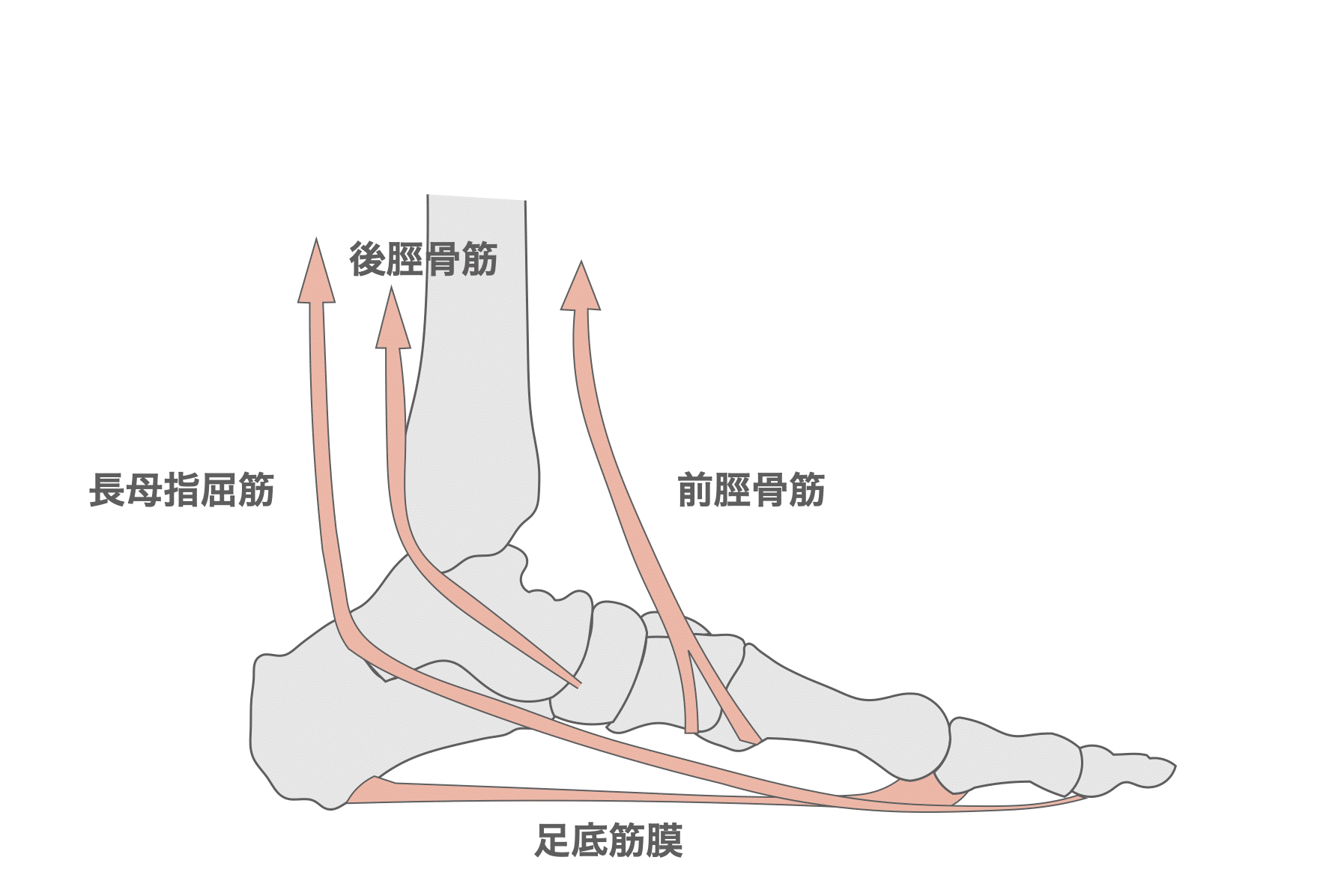
These muscles repeatedly contract and relax with the flexion and extension of the toes, maintaining enough muscle strength to support the arch.
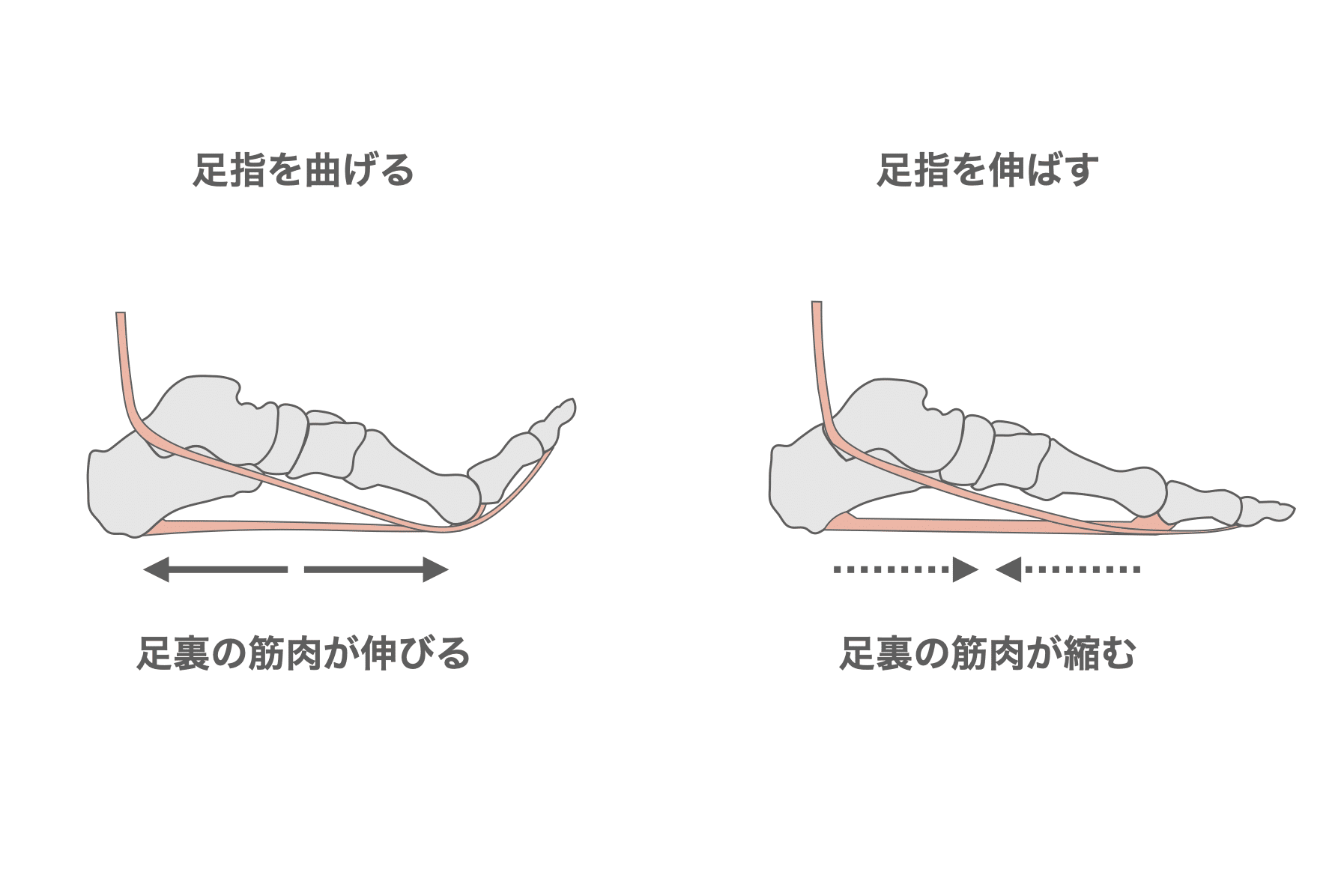
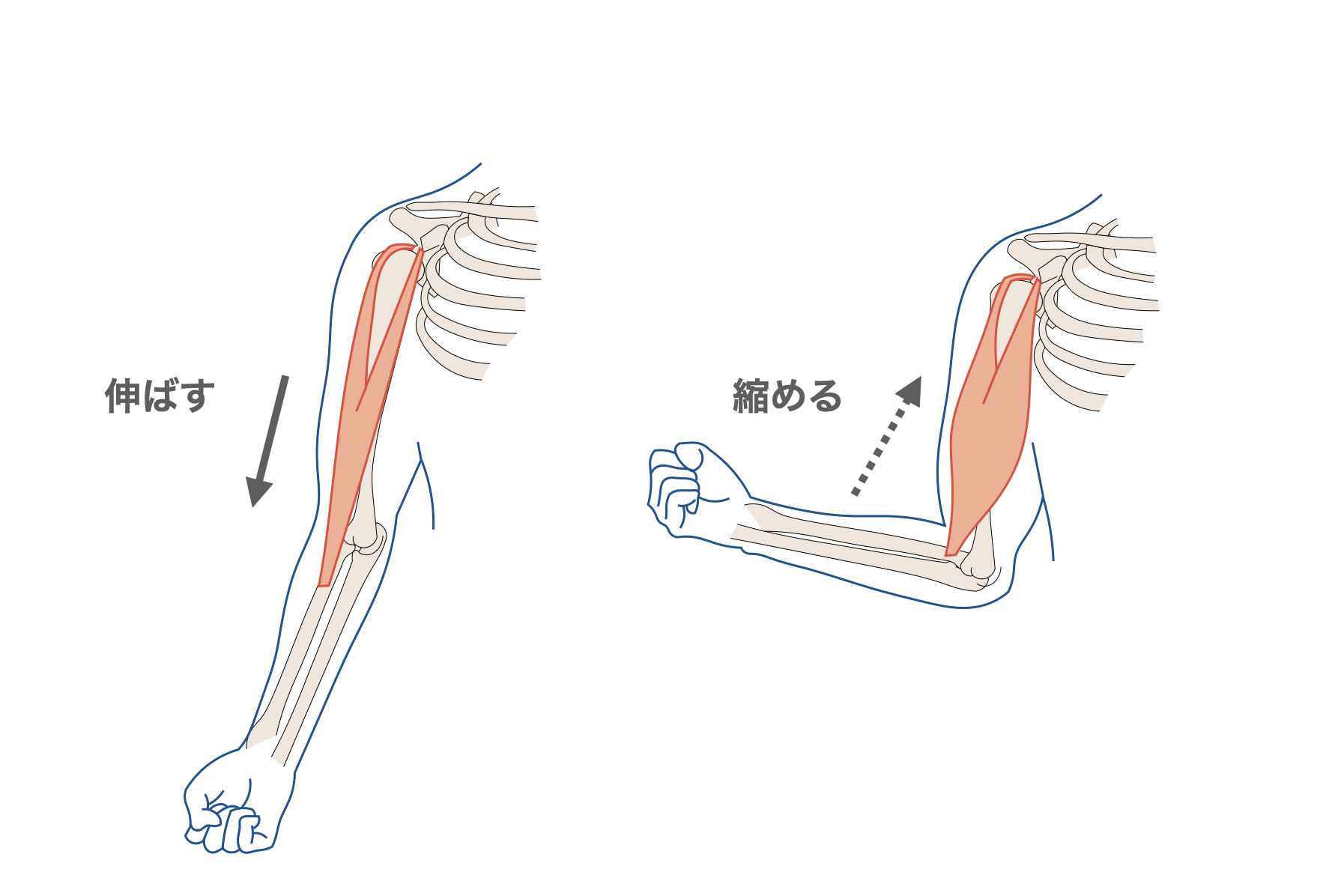
Muscle strengthening exercises by type of muscle contraction
● Afferent contraction
Exercise in which the muscle contracts while its length shortens
(e.g., biceps exercise when lifting dumbbells from elbow extension)
● Centrifugal contraction
Exercise in which the muscle contracts while the length of the muscle is stretched
(e.g., biceps exercise when lowering dumbbells from a bent elbow position)
Muscles are strengthened by bending and stretching joints while applying load. The "walk slowly with small steps" is an application of slow training, and it is believed to be highly effective in strengthening muscles even with low-intensity loads. The advantage is that, unlike big-legged walking, the load on the joints is small and the risk of orthopedic injury is low.
The single action of repeatedly bending and extending the toes is not performed in daily life. In fact, the "toe bending and stretching" action is performed when we kick the ground and step back with our toes when we walk. These three muscles are constantly being exercised because they are also bending and stretching the ankle at the same time.
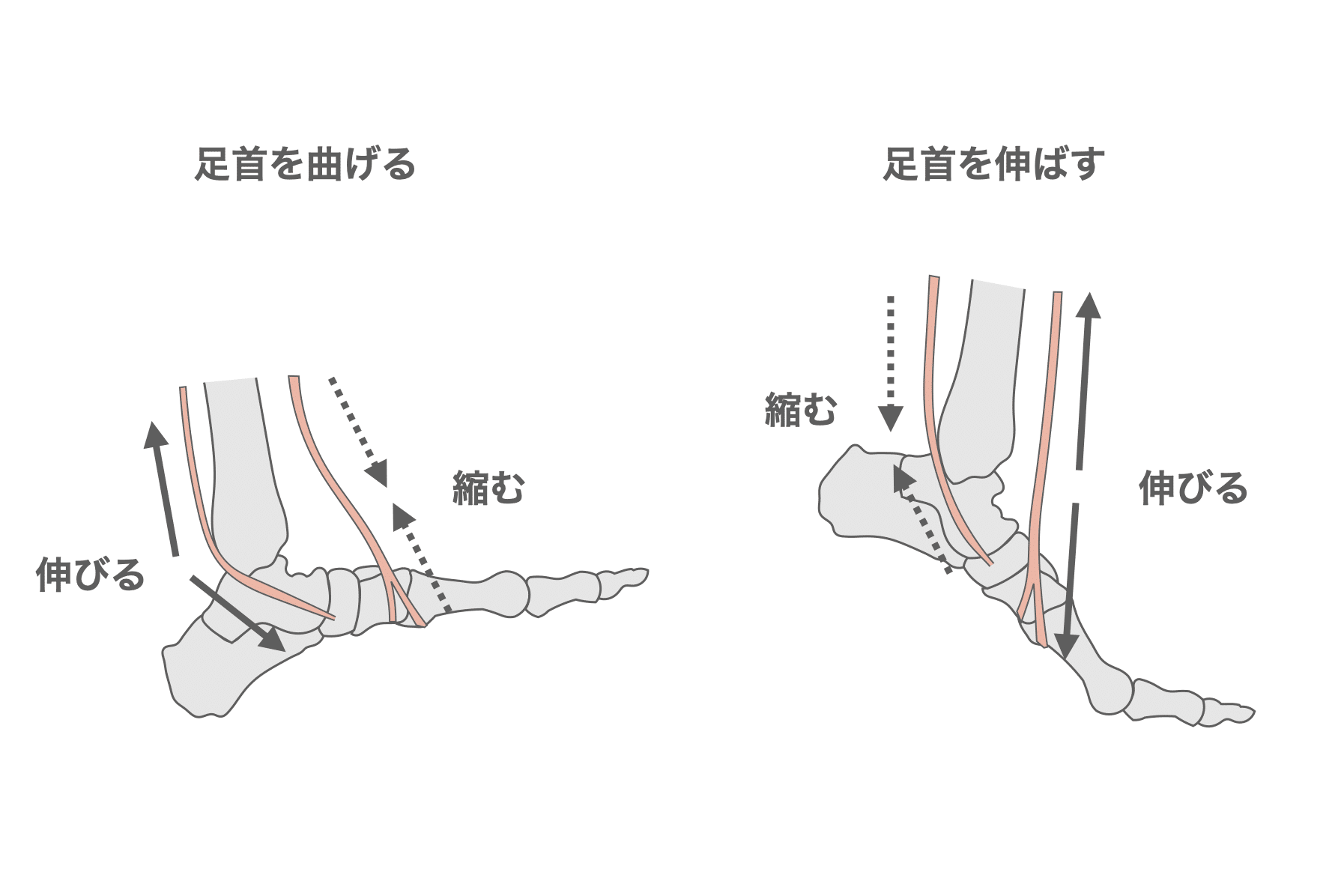
However,Toe deformities such as "flexed toes" and "floating toes" make the toe muscles stiff, making it difficult to exercise them effectively when walkingThere are times when it is not possible to correct a flat foot. Therefore, it is important to give priority to correcting "flexed toes" and "floating toes" in order to improve flat feet.
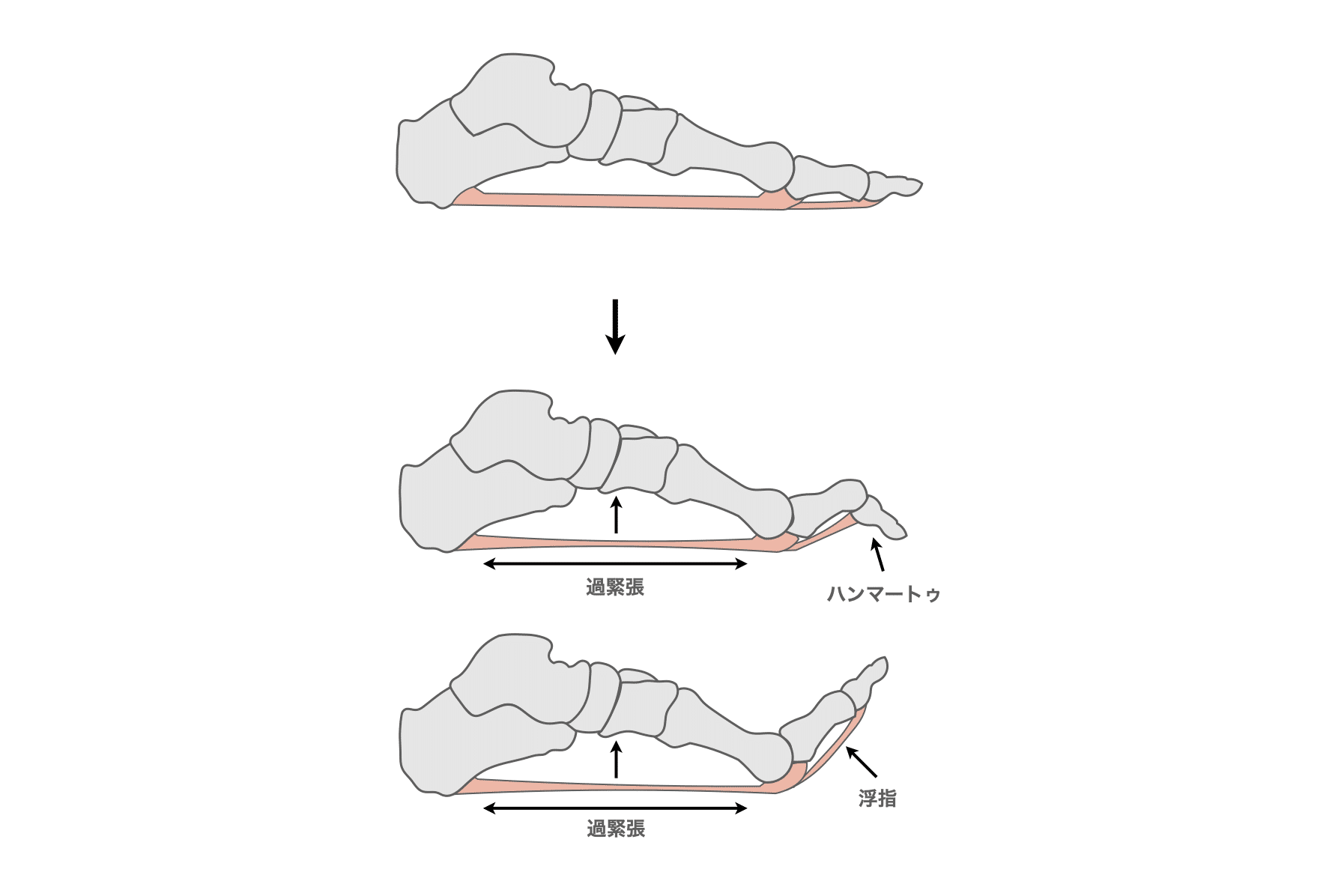
floating thumb
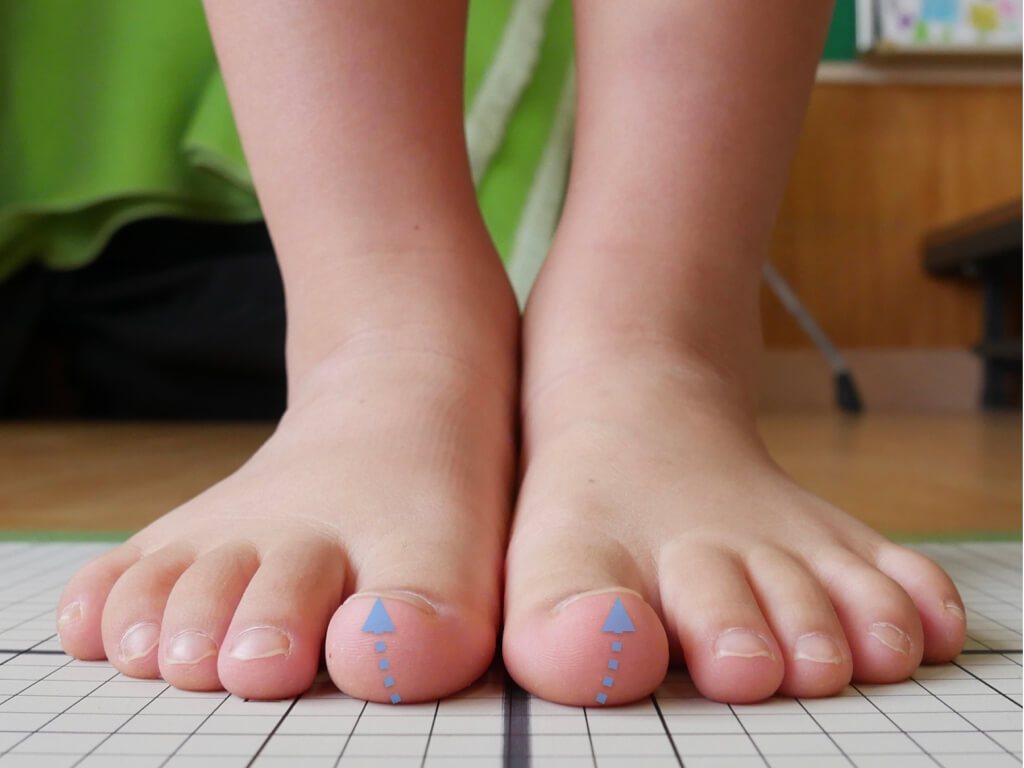
Take a picture of your foot with your phone from directly in front of you. If the thumb nail is difficult to see, you have a "floating toe".
floating pinky toe
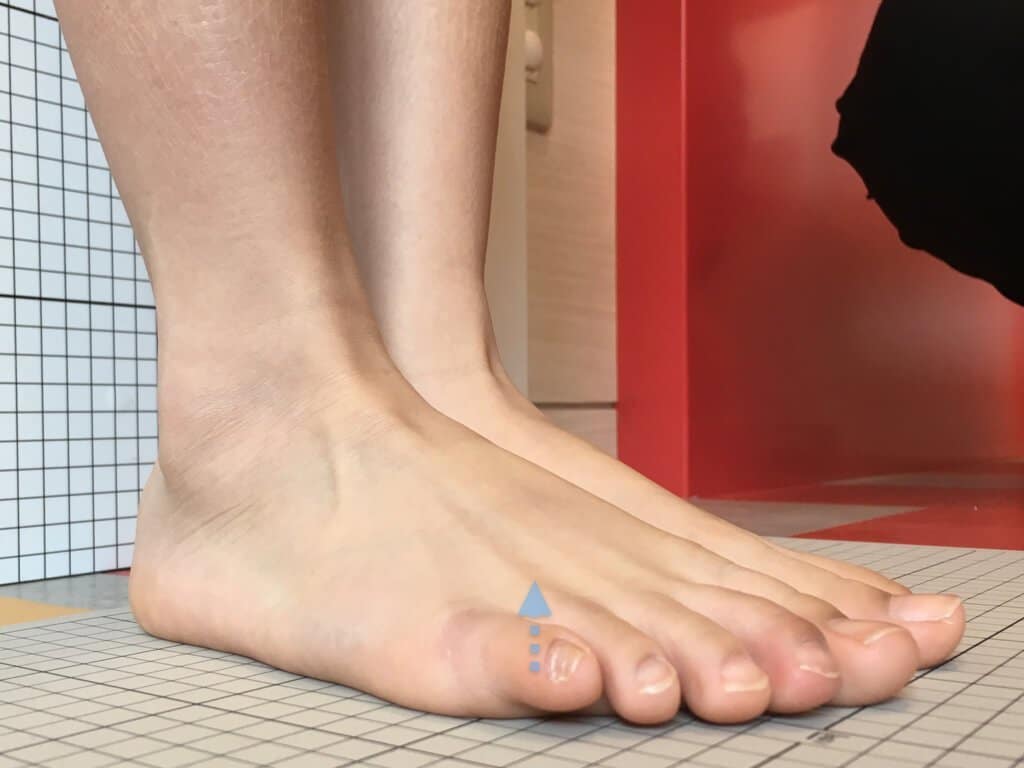
Take a picture of your foot from the side with your phone. If your toes are off the ground, you have "floating toes".
mirror finger
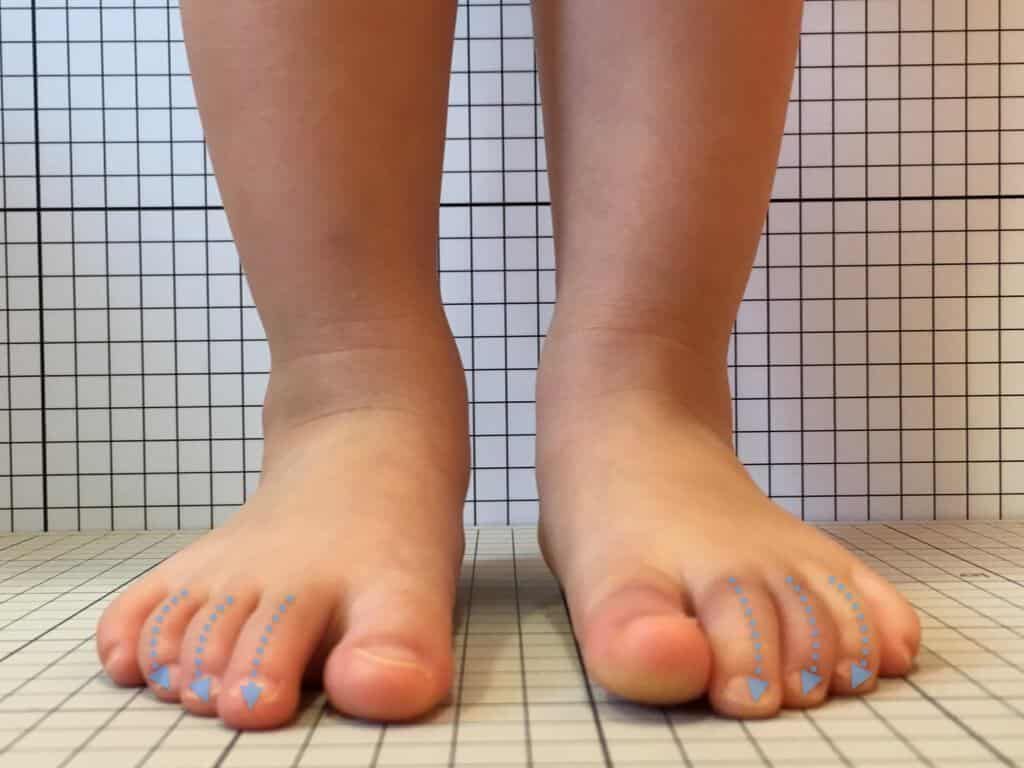
If you look at the foot from the front and the nail is facing downward, it is a "clawed finger".
ring finger
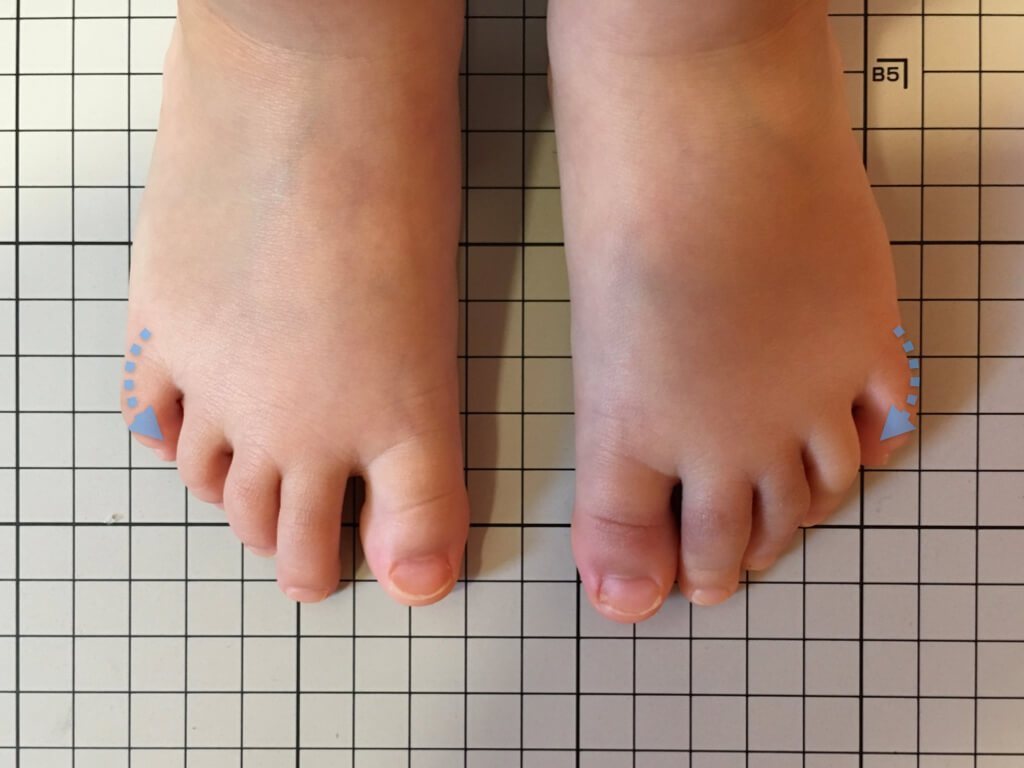
If the little finger or ring finger is lying on its side or bent in the shape of a "ku", it is a "sleeping finger".
hallux valgus
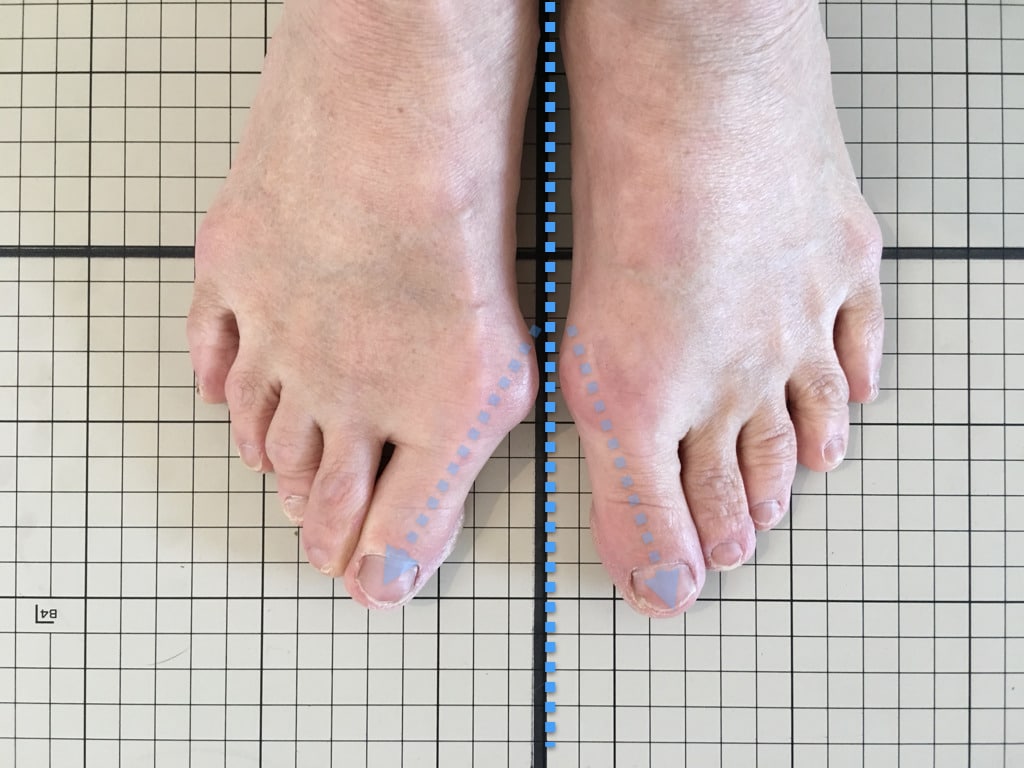
If the base of the thumb is bent outward or at an angle of 20° or more, it is "hallux valgus.
hallux valgus
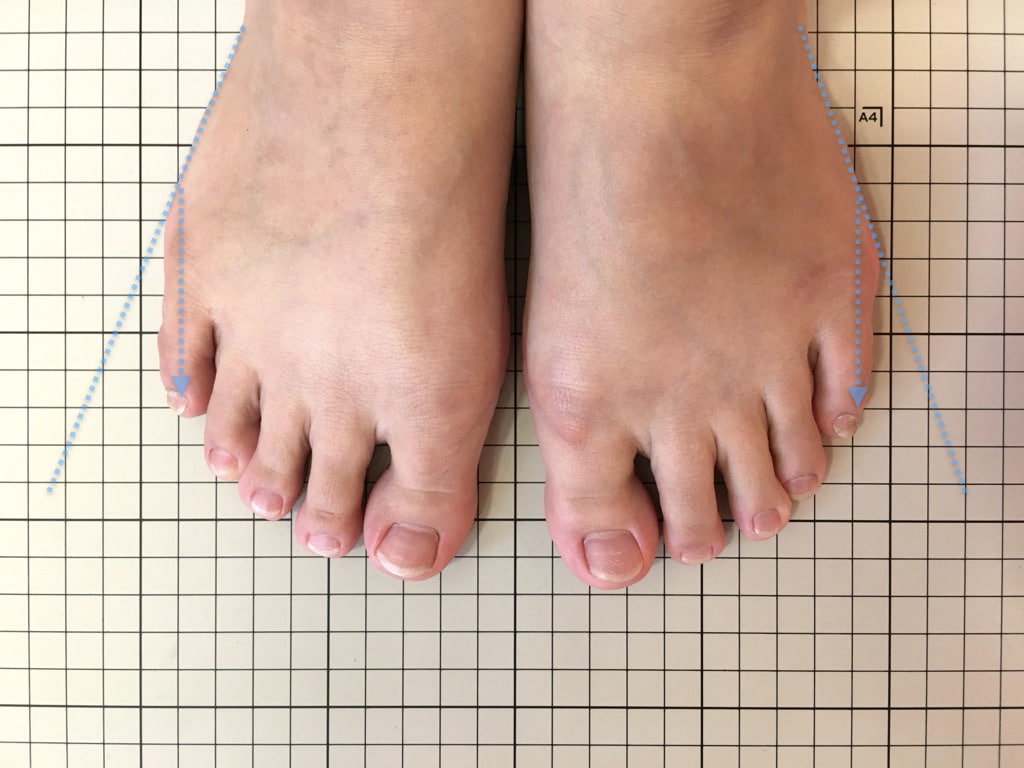
If the little toe (little toe) of the foot is bent inward or the base of the little toe is red, it is "hallux valgus.
Bendy toes" and "floating toes" are caused by feet slipping in footwear.. While it is important to correct toe deformities with "HIRONOBA EXERCISE" and "YOSHIRO SOCKS," it is also necessary to make sure that the laces are tight and that slippers are not worn.
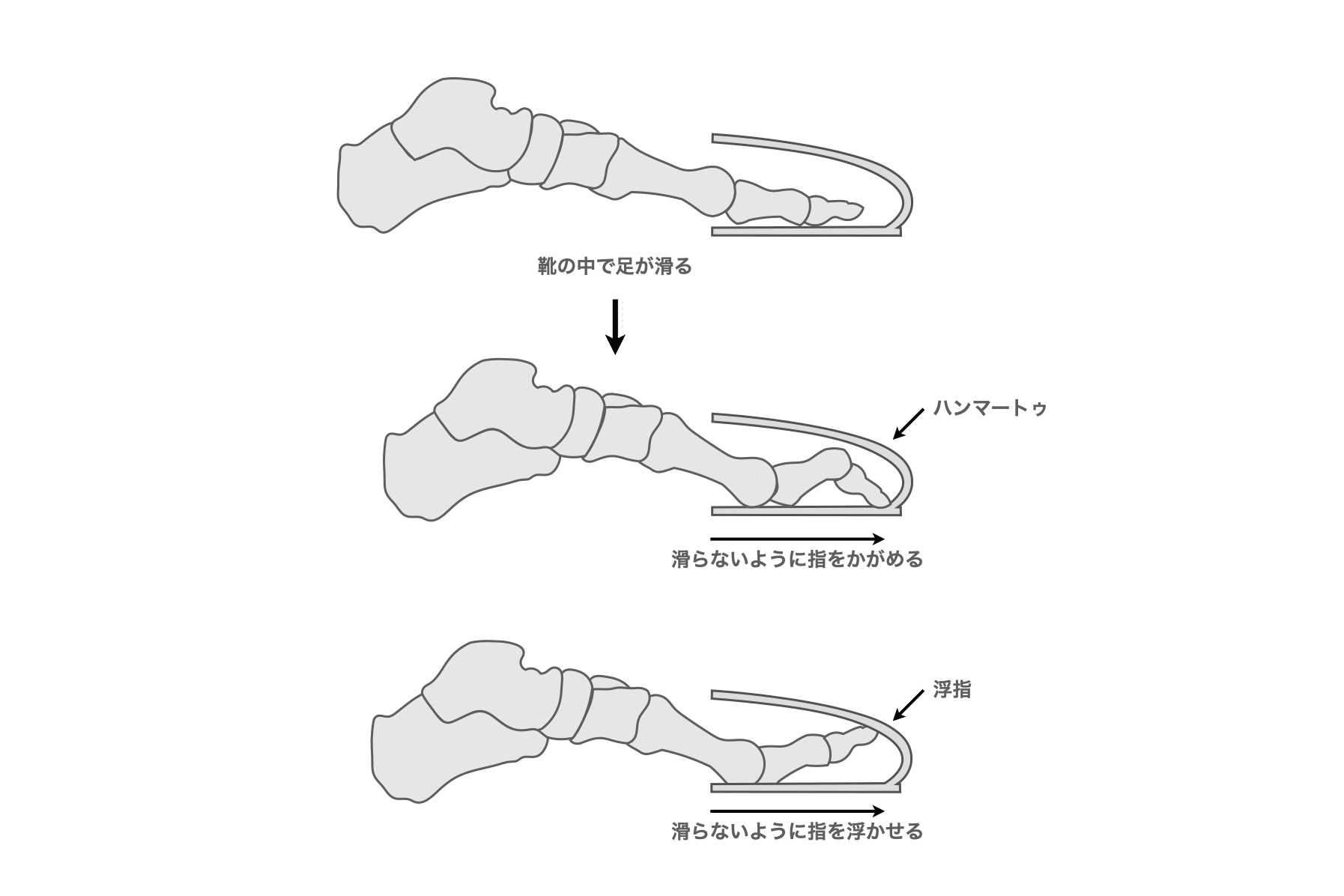
2. Flat feet due to thumb deformity or dysfunction
Another cause of flat feet is toe deformity (big toe, floating thumb) or thumb dysfunctionIt is. The thumb is a stopper that prevents the weight on the foot from falling inward, so if the thumb is not used, the foot will fall inward and the lower leg bone (bone below the knee) will bend inward (wanding).

And so on,Feet have normal arches at rest (when not standing or walking)However, when the foot makes contact with the ground while supporting its weight, the arch disappears. This is "hidden flat feet.
Relationship between flat feet and big toe
Flat feet are said to be a reduction of the longitudinal arch and open feet are said to be a widening of the transverse arch, but the actual definitions and diagnostic criteria are not clear. Therefore, it is difficult to examine the relationship between hallux valgus and flat or open feet because the papers are not unified and it is difficult to compare the two. Please read it only as a reference. The short answer is, "Maybe there is no relationship." That is to say.
Evidence Level 4: The relationship between hallux valgus and flat feet in adolescents was investigated, and flat feet were 8 to 24 times more common in hallux valgus patients, indicating that hallux valgus and flat feet are related.
Evidence Level 3: The foot and longitudinal arches are significantly reduced in the big toe, and the transverse arches are significantly enlarged.
Evidence Level 3The M1-M5 angle during loading is large in the elderly, pointing to an open foot as one of the etiologic factors.
Evidence Level 4: noted a relationship between HV angle and forefoot width (no explanation of the relationship between open foot and hallux valgus).
Evidence Level 3The longitudinal arch in the big toe is considered to be reduced due to the plantar flexion of the talus and the sinking of the navicular bone, but the relationship between the big toe and flat or splayed feet has not been mentioned.
Evidence Level 4The authors reported that there was no clear association between hallux valgus and flat feet in black African women based on radiographic images of 118 feet in 110 black African women.
Evidence Level 4: There was no significant difference in arch height between the hallux valgus group and the healthy group, and no correlation was obtained between the HV angle and the index of flatfooting. It is stated that flatfoot should be reduced in importance as an etiology of hallux valgus in young people.
Level of evidence 2: They reported moderate to severe flatfoot in 151 TP3T of the metatarsophalangeal cases. However, in these low-arch flatfoot cases, the postoperative improvement rate of the HV angle was not different from the overall improvement rate of the big toe, and no correlation was found between the low arch and the HV angle.
Evidence Level 4The results showed that the anteroposterior talonavicular coverage angle, lateral talometatarsal angle (Meary's line), and calcaneal pitch on simple radiographs were correlated with each other, making them good indices for evaluating flat feet. The study showed a correlation between the anteroposterior talonavicular coverage angle, lateral talometatarsal angle (Meary's line), and calcaneal pitch on simple radiographs.
Evidence Level 3The TNCA (talonavicular coverage angle) and lateral TMTA (talo-first metatarsal angle) angles, which correlate with flat feet, were significantly greater in the hallux valgus group than in the control group, suggesting that hallux valgus is associated with flat feet. The results showed that the toe was flat.
Evidence Level 4: Reported that an evaluation method using tracing showed a significant correlation between metatarsophalangeal angle and open foot.
Evidence Level 4: In a bunion surgery with flat foot complication, the flat foot was reported to have improved along with the HV angle.
Thus, there are many cases reporting the association between the big toe and the longitudinal and transverse arches, but there are both positive and negative opinions about the association with flat and open feet.
| Ia | meta-analysis or systematic review of RCTs |
| Ib. | RCT |
| II | CCT and cohort studies |
| III | case-control study |
| IV | case series |
| V | case report |
| VI | Other |
Diagnosis and Examination of Flatfoot
How is flatfoot diagnosed?
Self-assessment of flat feet can be done simply by wetting the feet, standing on a flat surface (such as a concrete sidewalk) where the footprints are visible, and looking at the footprints away from there. If complete traces are visible on the surface of the sole of the foot, the patient may have flat feet. If flat feet are suspected along with any of the above symptoms, you should be examined by a foot and ankle specialist.
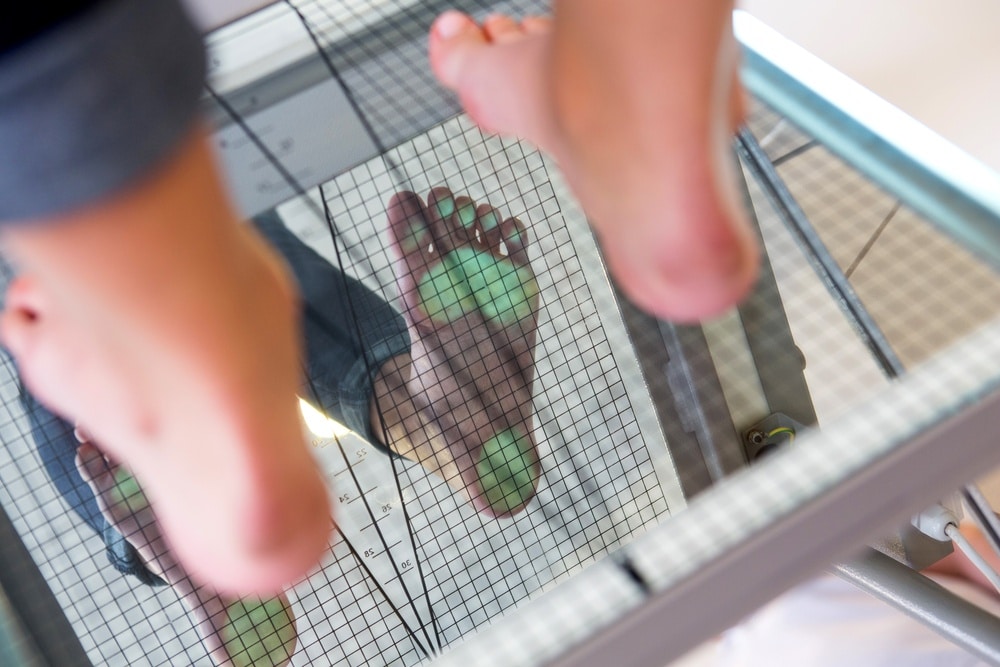
Physical examination includes identification of the source of pain, foot and ankle alignment evaluation, and strength assessment of surrounding ligaments/tendons. Additional investigations typically include imaging studies using X-rays and CT scans. If detailed imaging of both hard and soft tissue is needed, an MRI scan may be further considered. Nevertheless, to avoid unnecessary investigations, the diagnostic tests needed to make a definitive diagnosis depend primarily on the results of the physical examination, which may vary from person to person.
Treatment of flat feet
How are flat feet managed or treated?
Non-surgical treatment is usually considered the first treatment option when pain occurs in flat feet.Depending on the cause and severity of the flat foot, these conservative treatments may include arch supports (orthotics), supportive shoes, stretching exercises especially for the Achilles tendon, and physical therapy such as ultrasound and laser devices. Additionally, painkillers can be taken as prescribed to relieve pain and reduce inflammation. All of these treatments are coping therapies, which provide temporary pain relief, but do not provide a fundamental cure.
The flat foot progresses and the patientIf not responding to conservative treatment, surgery is performed to realign the bones and strengthen the tendons that support the arch of the footIn some cases. The goal of surgery is to restore the patient's range of motion, increase normal mobility, and return to daily activities and routines as soon as possible.
When foot pain, stiffness, or other problems develop, your health care provider may recommend nonsurgical treatment. In rare cases, surgery may be needed to correct stiff, flat feet or bone and tendon problems. Treatment options include the following.
1)Nonsteroidal anti-inflammatory drugs (NSAID)and rest and ice to relieve inflammation and pain.
2) Stretch and strengthen stiff tendons and muscles to improve flexibility and mobilityPhysical Therapy.
(3) Foot orthotics, foot or leg braces, and custom-made shoes.Auxiliary equipment.
4)procedureis not only performed to treat flat feet. Surgery may be an option if a patient still has activity-limiting pain after attempts at nonsurgical treatment.
STEP 1. Let's try the Hironoba Exercise, a stretch to prevent and improve flat feet!
The cause of flat feet is muscle weakness due to "toe deformity" and "toe dysfunction. Since the fundamental treatment is to enable the toes to use their functions when walking, you should regain toe function with "HIRONOVA EXERCISE" and improve toe deformity with "YOSHIRO SOCKS". If there are still no signs of improvement, it is necessary to review "shoes" and "walking style" as well.
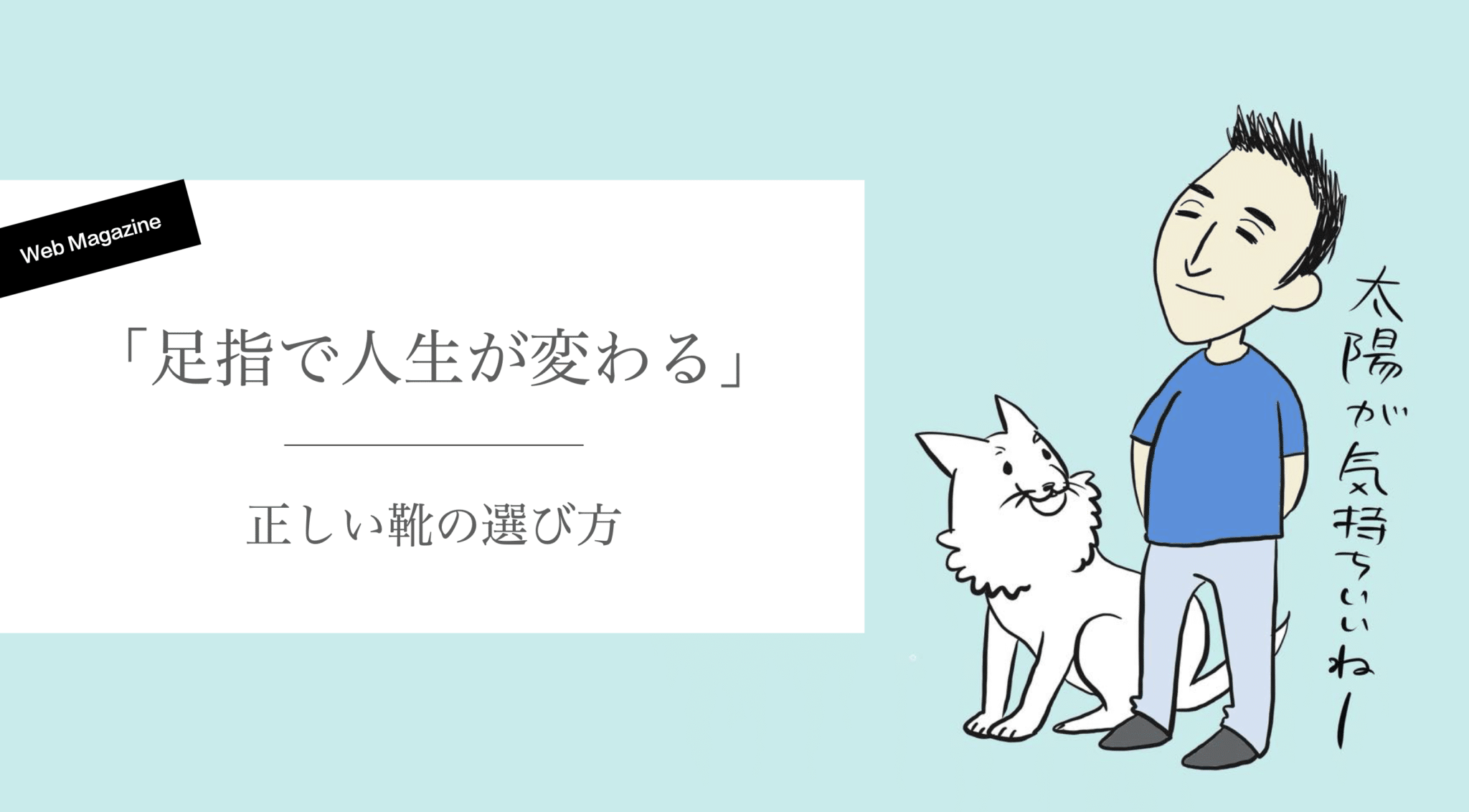

What kind of gymnastics is Hironoba Gymnastics?
Hironoba Exercise" is a toe biomechanical stretching exercise based on podiatry, invented and developed by Keiro Yuasa in 2008, in which the toes are spread (=hiro) and stretched (=noba). For mild to severe flat feet, toe stretching can improve symptoms. It is also ideal for prevention purposes.
(If your goal is to improve an illness or condition, the more often you do it, the easier it will be to see results.) It is surprisingly easy to do, so let's start by watching the video and practicing! Once you know how to do the exercises, you can easily do them before bed, in the bath, while watching TV, or anytime. First of all, try to do it for 2 weeks.
STEP 1 Sit on a chair or on the floor and place one leg on the thigh.
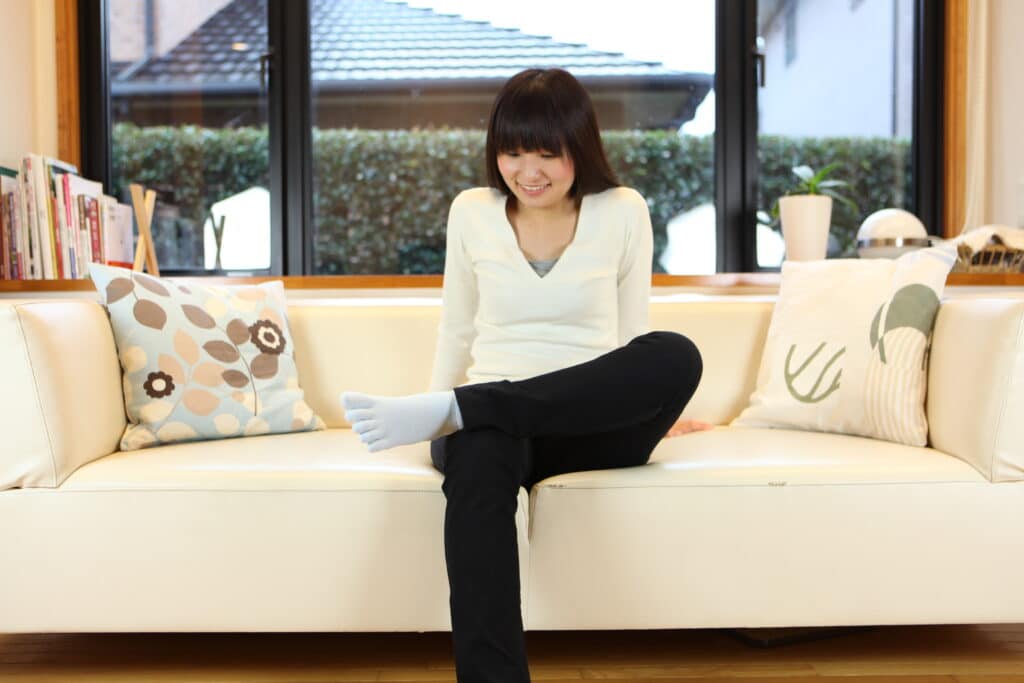
Tilt knees down as far as possible
...to prevent the ankle from turning upward.
Place feet properly on the thighs
STEP1-2 Check from above to make sure your feet are in the correct position.
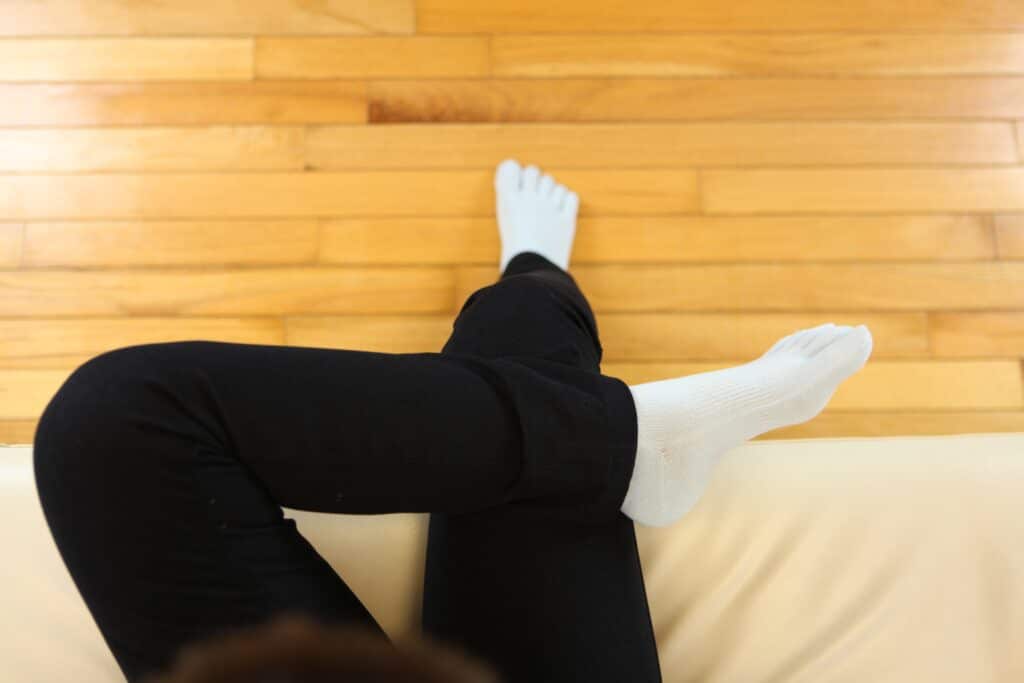
The back of the foot should be turned in firmly.
The ankle should come out slightly from the thigh.
STEP2-1 Place the fingers of your hand between your toes.
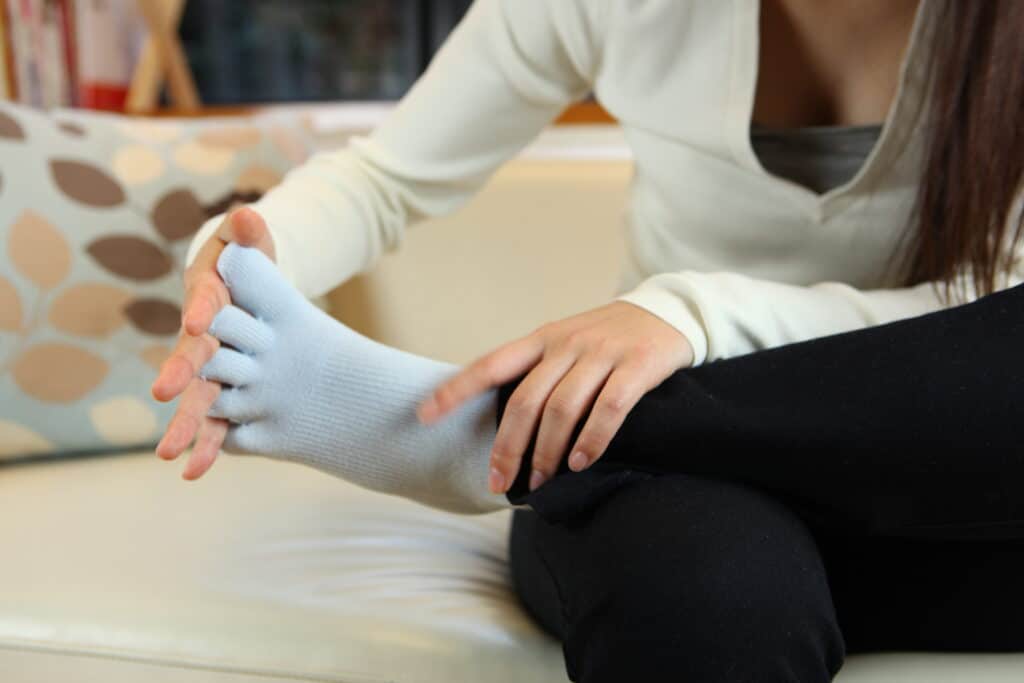
...Put the tip of one toe in the base of each finger.
Allow clearance at the base of the toes.
STEP2-2 Check the position of the inserted finger.
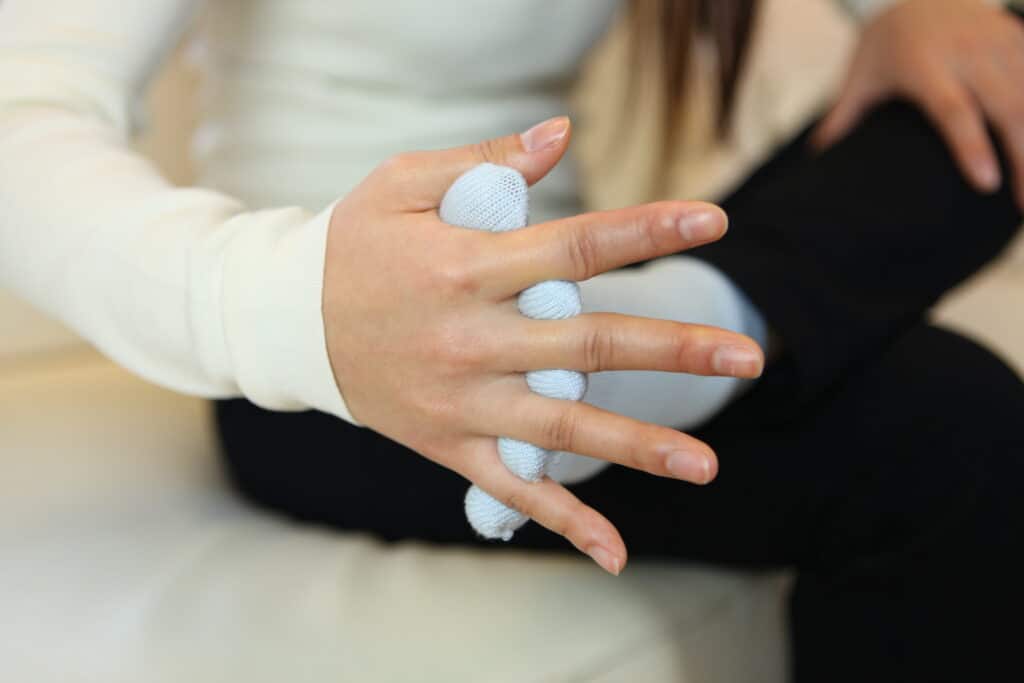
I feel like only the tips of my toes ride on the base of my hands.
...and toes snugly against the base of the hand.
STEP2-3 Don't put too many fingers of your hand between your toes.
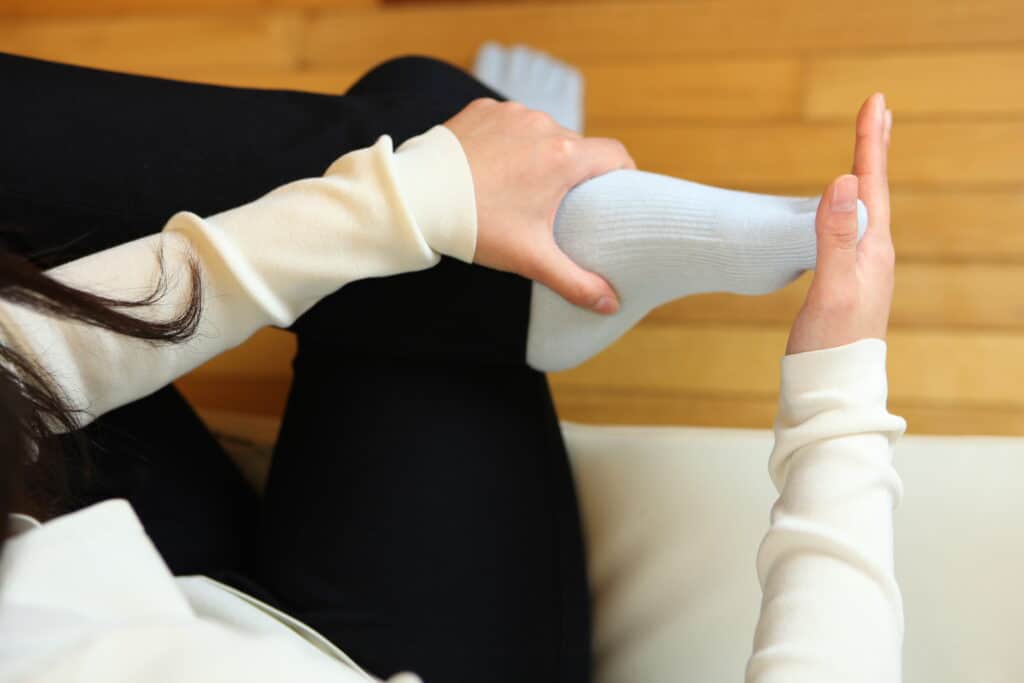
Ideally, the toes should not protrude from the fingers.
NG Be careful not to get into the base of the foot.
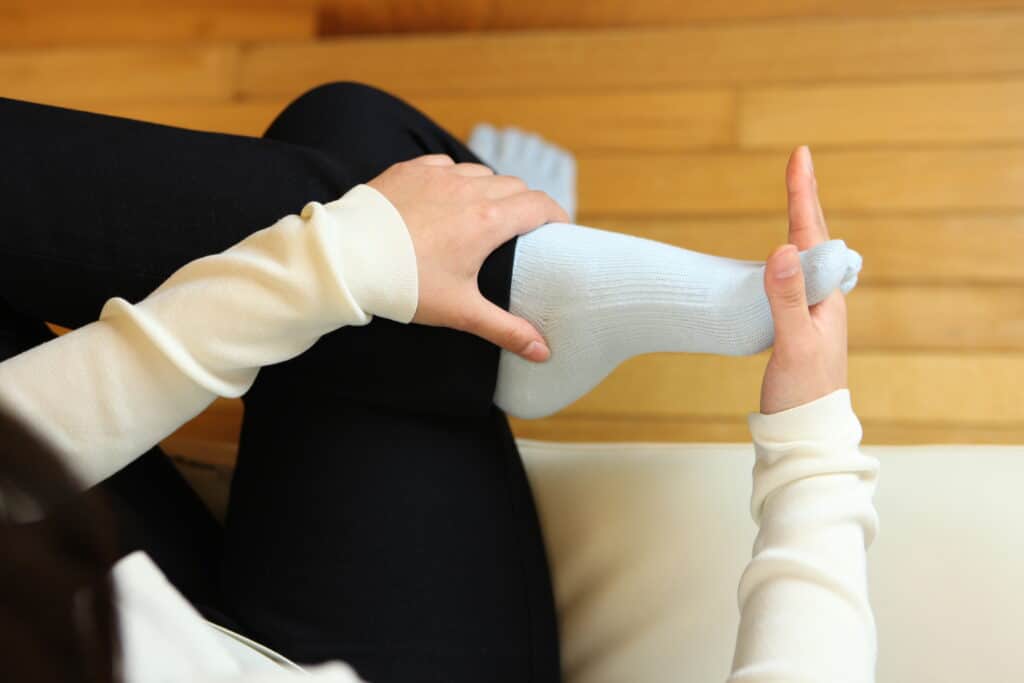
...If you put your fingers in to the base of the toes, you will not be able to bend them properly.
STEP3 Gently grasp the hand with the toes in it.
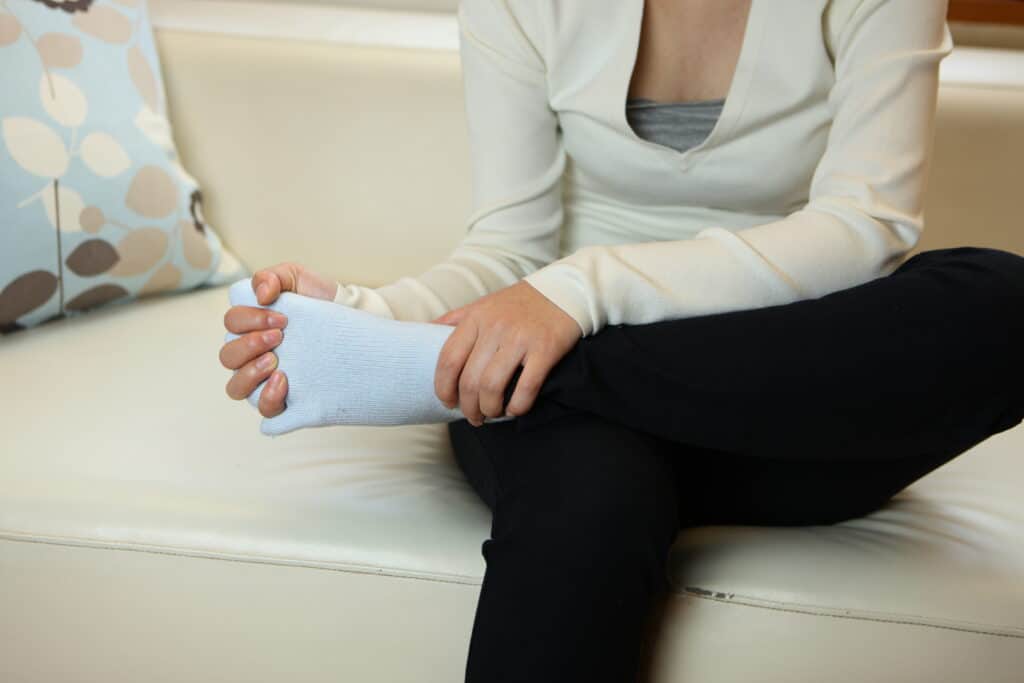
Hand comes to a little above the base of the toes.
Press the thumb of the foot lightly with the thumb of the hand.
gaffe
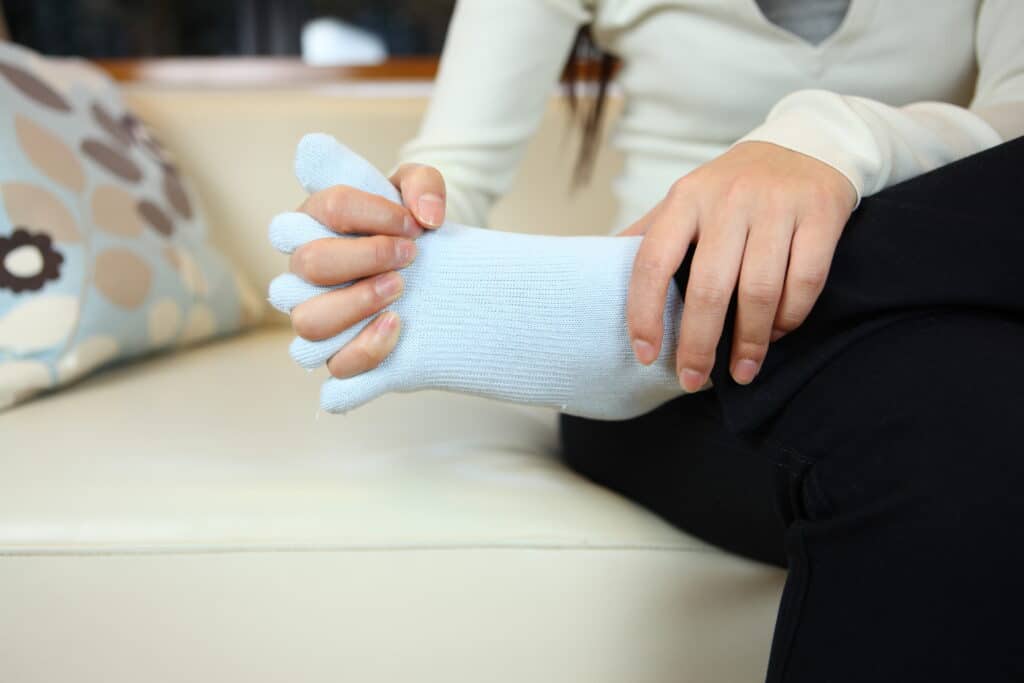
It is difficult to warp when the fingers of the hand are inserted all the way to the base of the foot.
STEP4 Turn your toes toward the instep.
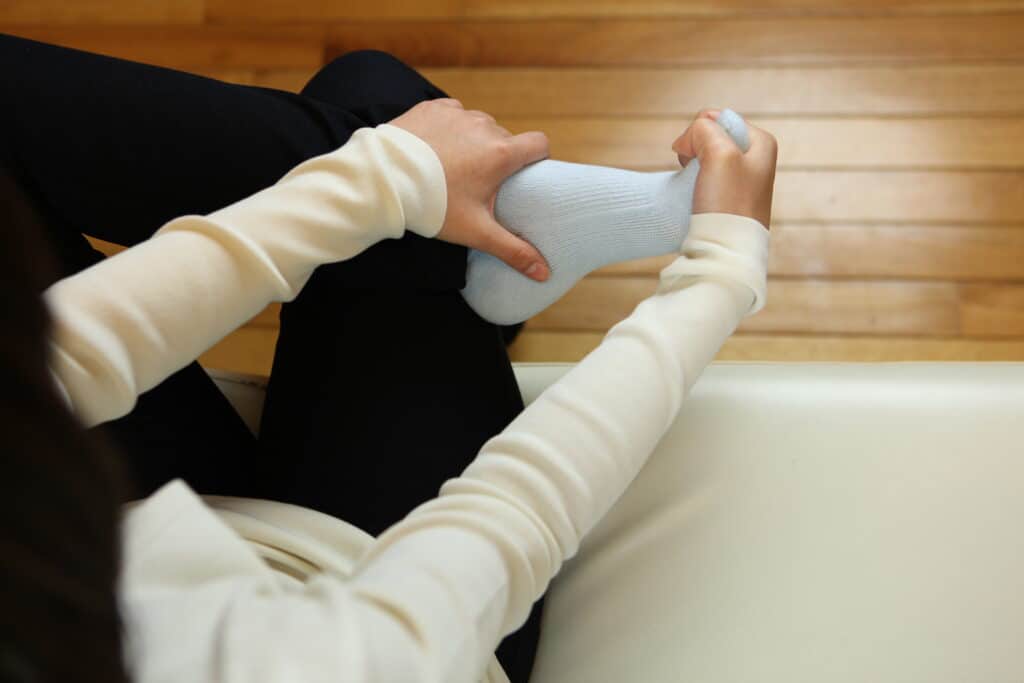
Gently and slowly warp
Press your toes with the base of your hand.
Ideally, the toe joints should be at 90 degrees.
(Do not overdo it if you are stiff)
Once warped, hold for at least 5 seconds.
(If stiff, hold for 30 seconds)
STEP5 Turn your toes toward the instep.
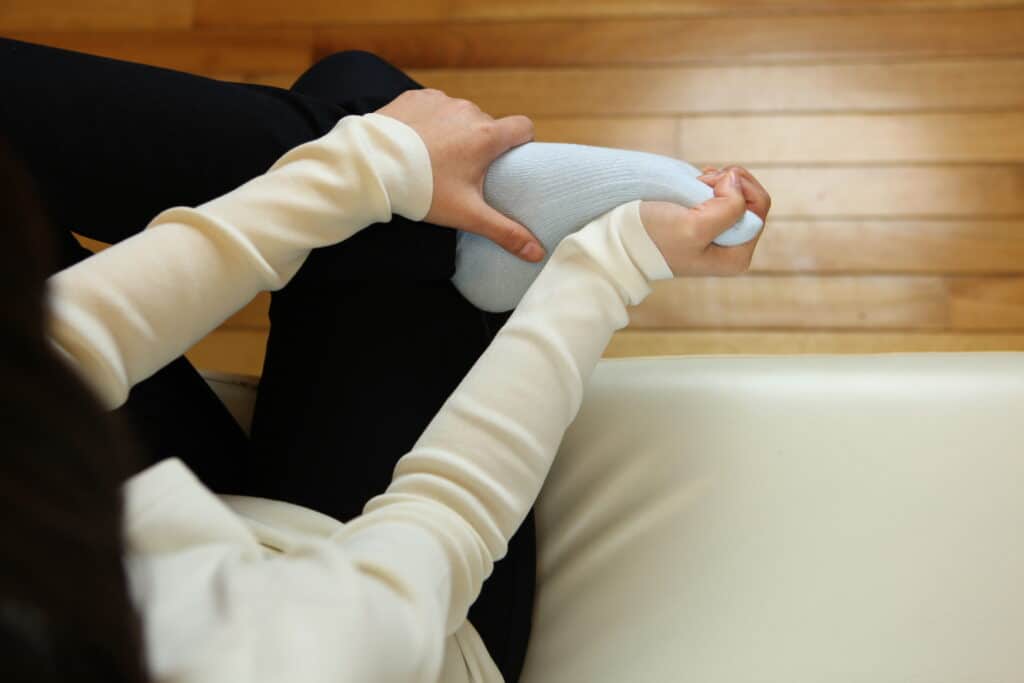
Gently and slowly
Warp the back with the image of stretching the instep.
Press the sole of the foot lightly with the whole palm of your hand.
Once warped, hold for at least 5 seconds.
(Hold for 30 seconds if stiff)
STEP6 Repeat STEP4 and 5
After repeating STEP 4 and 5, turn the opposite leg in the same manner. It is OK if you can do both legs for at least 5 minutes; if you are stiff, it is more effective to do one leg for 10 minutes.
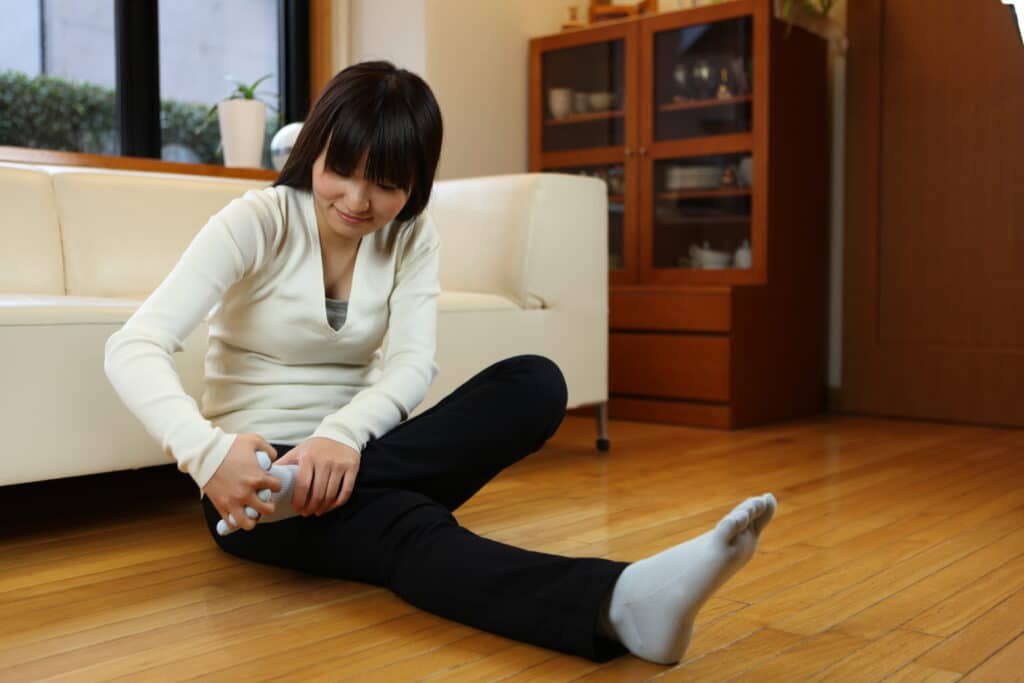
If it is difficult to do it yourself, have someone else do it for you.
Application of Hironoba Exercise (how to grab the little finger)
STEP 2. Avoid wearing slippers or slippers indoors.
Ankles are not fixed and toes are contracted
Many patients who come to me with foot problems wear slippers in the house. At first glance, slippers seem wide enough to take pressure off the toes. However, since the ankle is not fixed, walking is always unstable. As a result, the foot easily slips inside the footwear, causing the slippers to flop off with each step.
In an attempt to prevent this, the toes naturally become bent, which causes the toes to become strangely strong. This is the beginning of bent toes, which leads to weakness of the foot muscles and flat feet. Some people walk with their toes in the air to prevent their slippers from falling off, but this can also cause a floating toe, so care should be taken.
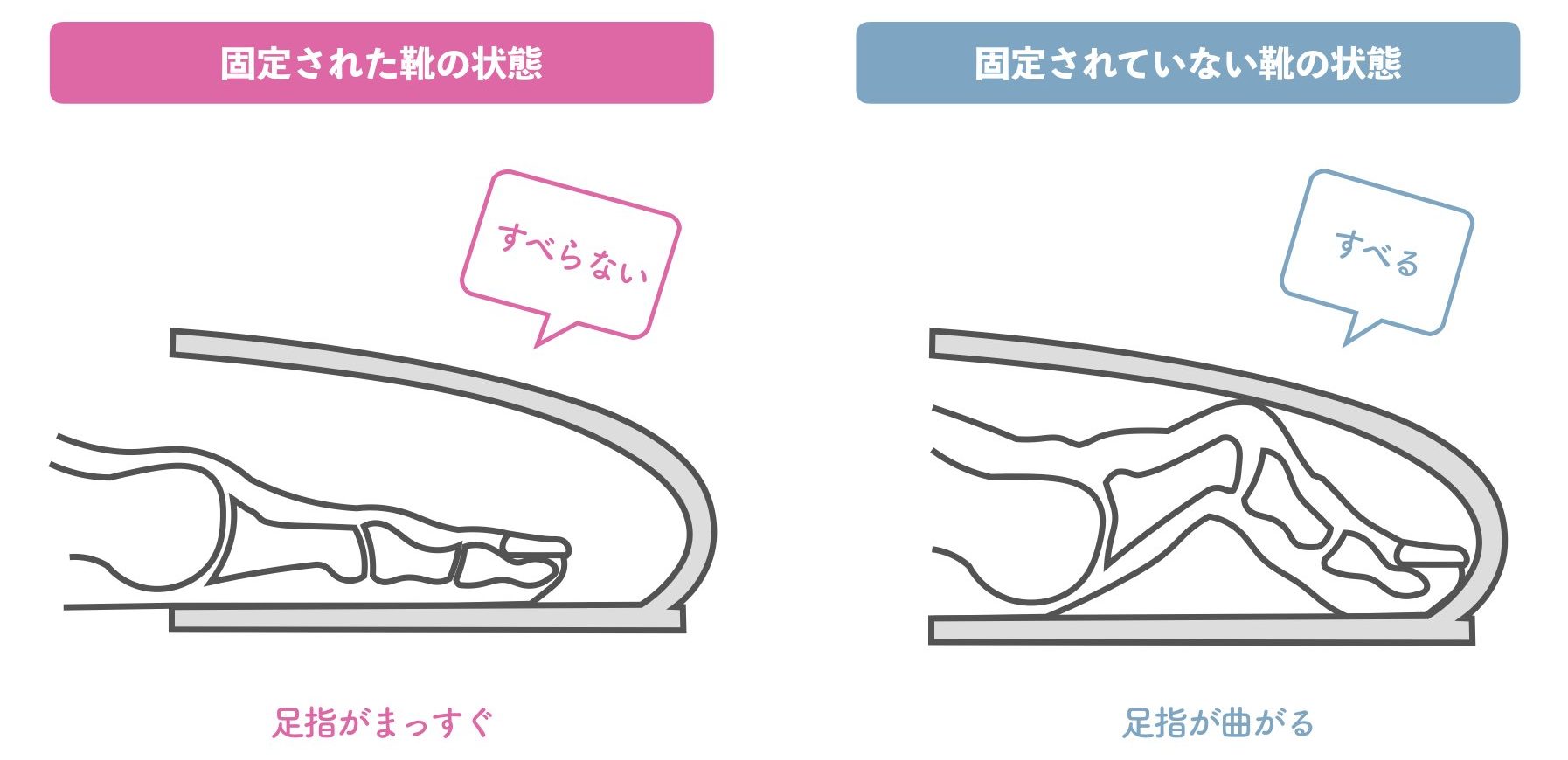
The picture below compares how the toes change between slippers and bare feet. Although they are the same feet, after wearing slippers for a while, the toes are bent and the big toe and little toe have become bunions or hallux valgus. To reduce the stress on your toes, either stop wearing slippers or shorten the time you wear them as much as possible. If you don't want to take them off because your feet are cold, wear leg warmers or other foot warmers to expose only the tips of your toes, or place a rug around your feet if you don't like to get your feet dirty.
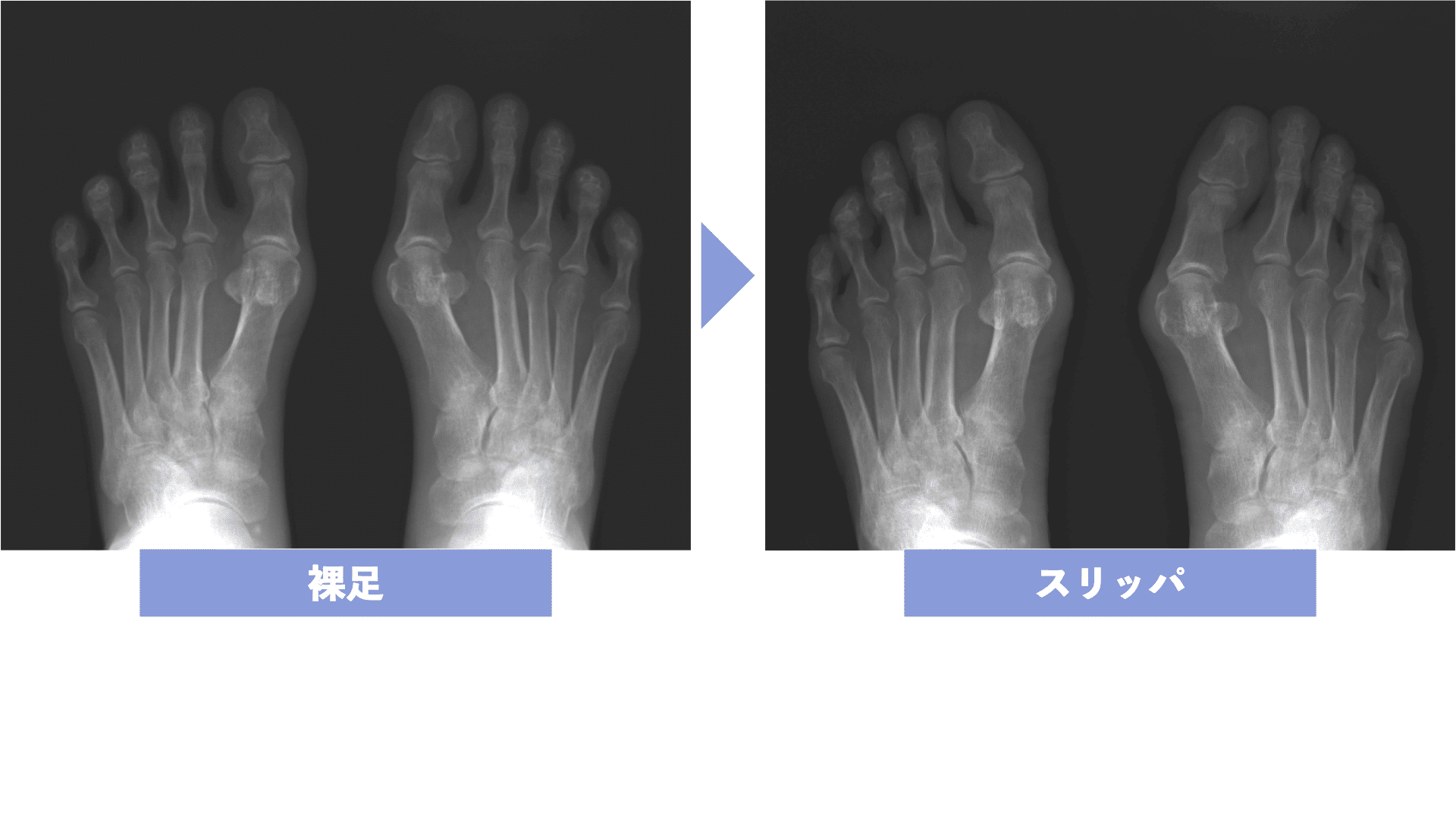
Women, in particular, spend a lot of time standing in the kitchen, so whether or not they wear slippers greatly affects the health of their feet. If you have been wearing slippers out of habit, why not take this opportunity to get rid of them?
The same is true of zori, in that they do not hold the ankle in place. These days, we see many people wearing them to strengthen their toes and because they were worn by people in the olden days and are therefore healthy. But did you know that the original zori actually had a kind of cord to secure the ankle? Since some time ago, ankle braces have been simplified for the sake of fashion, but we need to be careful not to have the wrong impression that "old-fashioned = healthy".
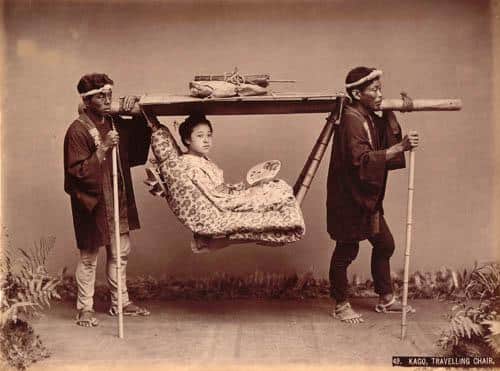
STEP3: Corrective support socks to improve flat feet
To maximize the effects of Hironoba Gymnastics, we developed YOSHIRO SOCKS, five-toed socks for correction, based on podiatry, to help the toes spread even wider, leading to more effective improvement of flat feet. For those with severely deformed toes or those who wish to obtain quick results, we recommend the combined use of HIRONOBA Gymnastics and YOSHIRO SOCKS.
State-of-the-art fibers, state-of-the-art construction.
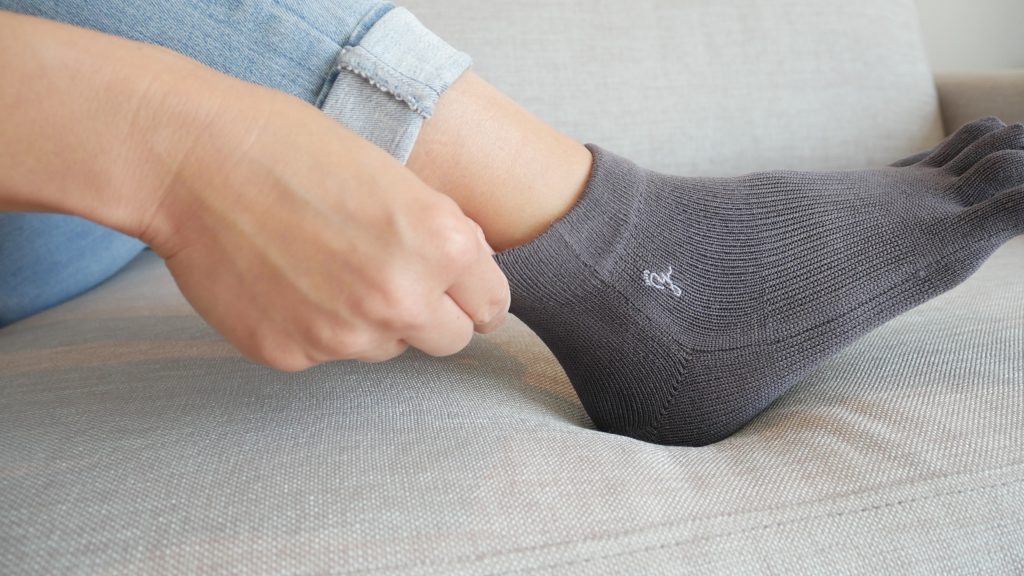
The 19 years of knowledge and experience in foot education that I have accumulated as a physical therapist specializing in toes have been condensed into these 5-toed socks. Simply by wearing the socks, the toes are expanded and stretched, and the body is restored to its natural posture and athletic ability. This is the only reason we developed YOSHIRO SOCKS.
Scientific Effects of Corrective Socks on Toe Deformity
Changes to the toes
YOSHIRO SOCKS prevent flat feet, which are caused by muscle weakness in the sole, by improving toe deformity and making the toe muscles more efficiently usable. 90% of Japanese people have floating toes with crouched toes that prevent them from using their toes. But YOSHIRO SOCKS have a structure that allows the toes to grip the ground firmly, which improves the ability to fluff unconsciously and regains the muscular strength of the sole.
Hallux valgus angle
The big toe angle at the start is19.1°, with a maximum of
The big toe angle after 8 weeks is12.3°
The average value at the 8th week was 6.8° improvement of the big toe angle compared to the beginning. The action of improving the metatarsophalangeal angle was confirmed.
3 Difference between the mean before the start and at the 8th week
*Graphs show average values in clinical trials.
*Results may vary from person to person and are not guaranteed to be 100%.
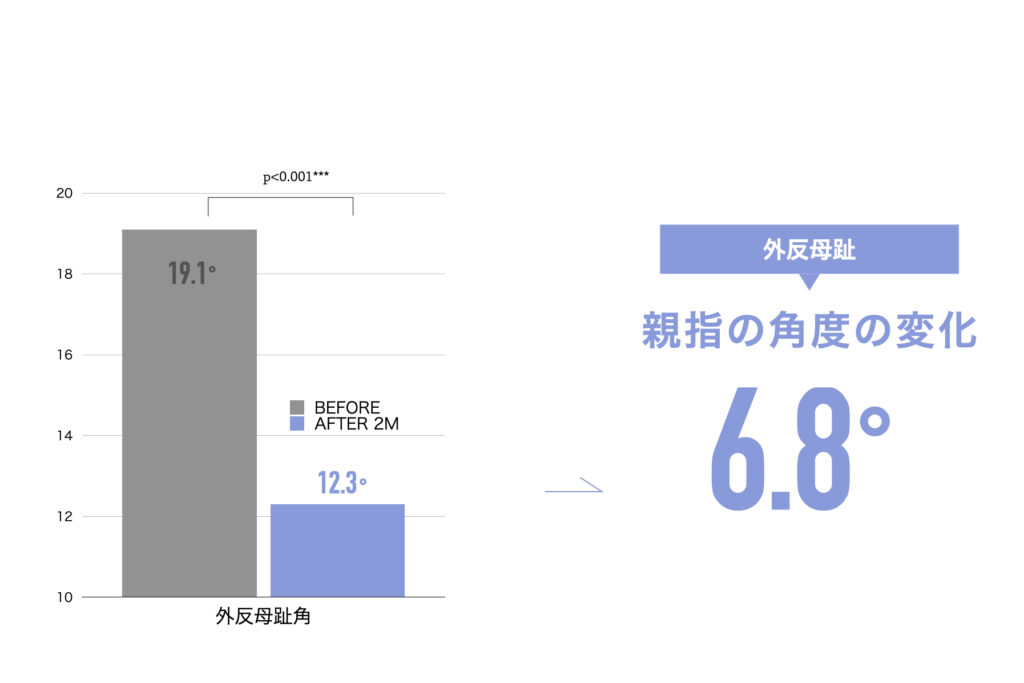
Thus, YOSHIRO SOCKS are made using a special manufacturing method (patent pending) that naturally widens closed toes and straightens bent toes and floating toes just by wearing them.
Difference from ordinary five-finger socks
Shape of YOSHIRO SOCKS
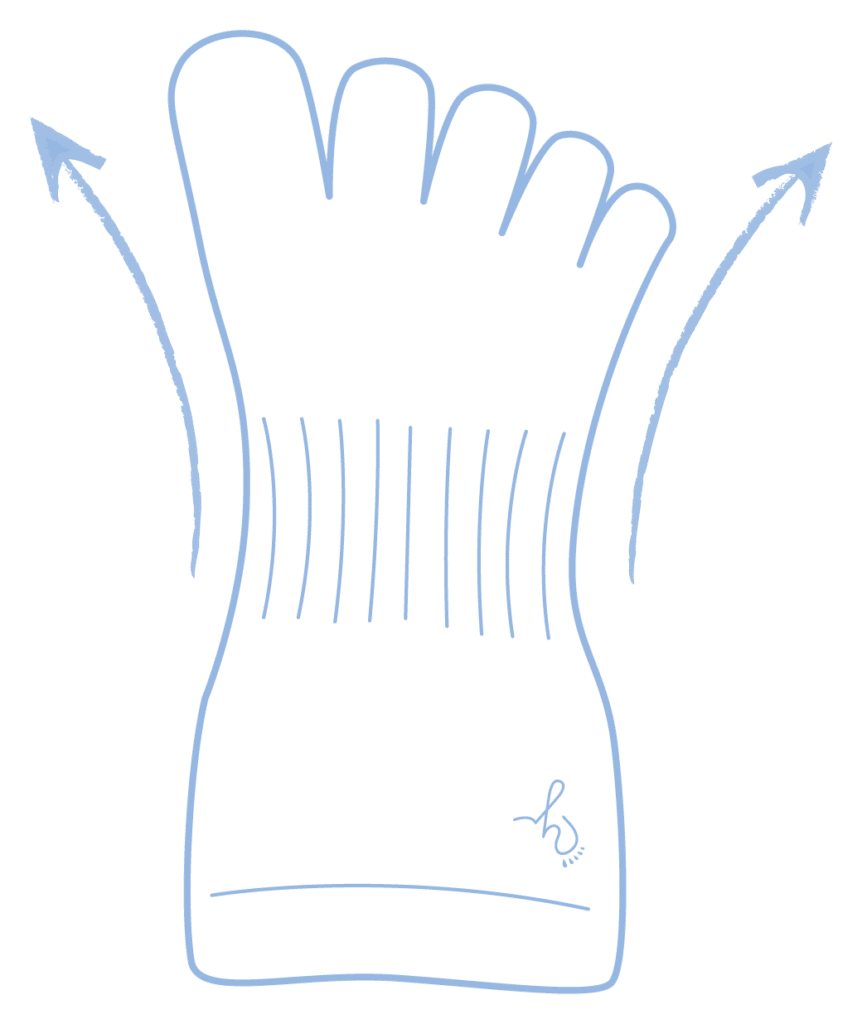
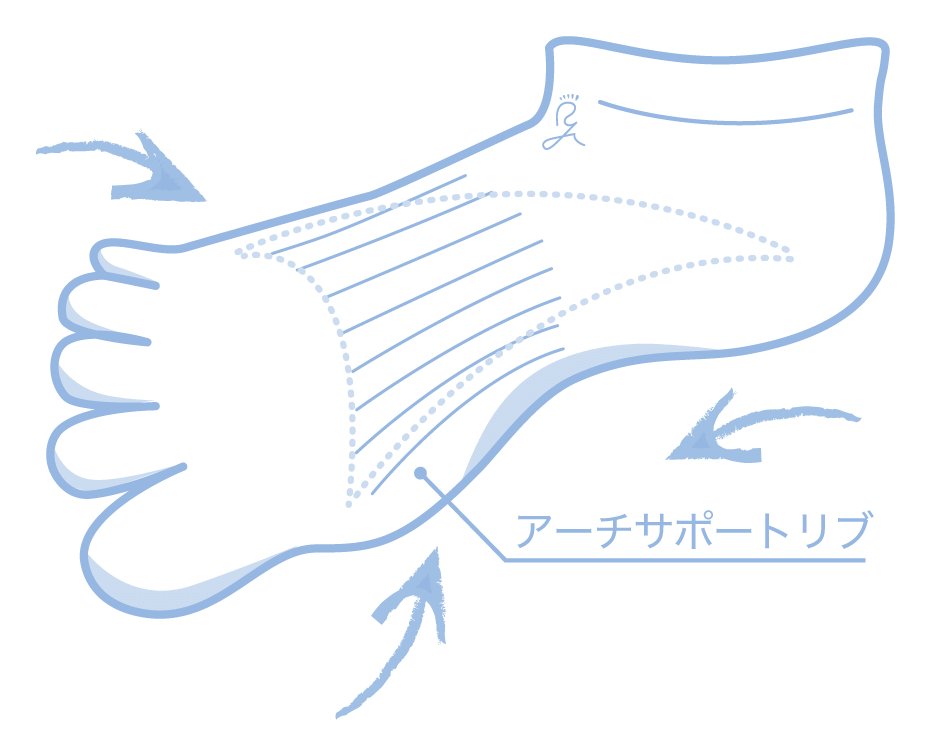
YOSHIRO SOCKS have a special manufacturing method (patent pending) that naturally spreads the toes into an ideal shape, and a shape-memory structure that keeps them in that state.
General 5-finger sock shape
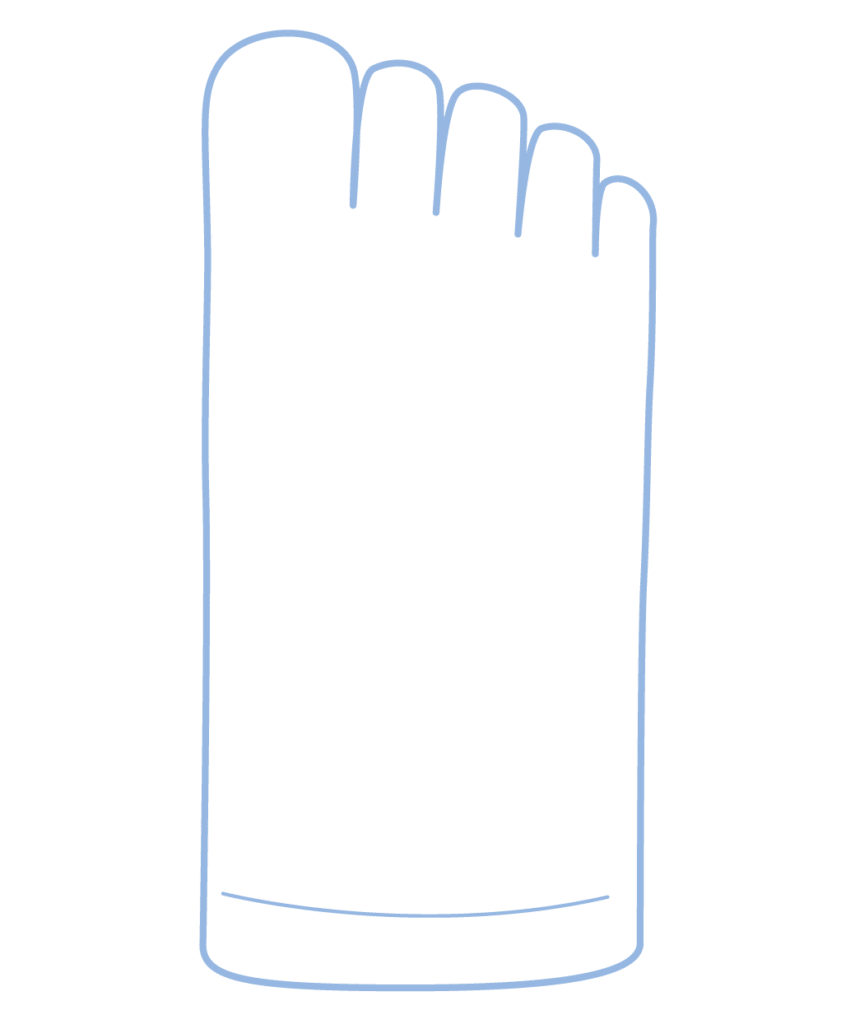
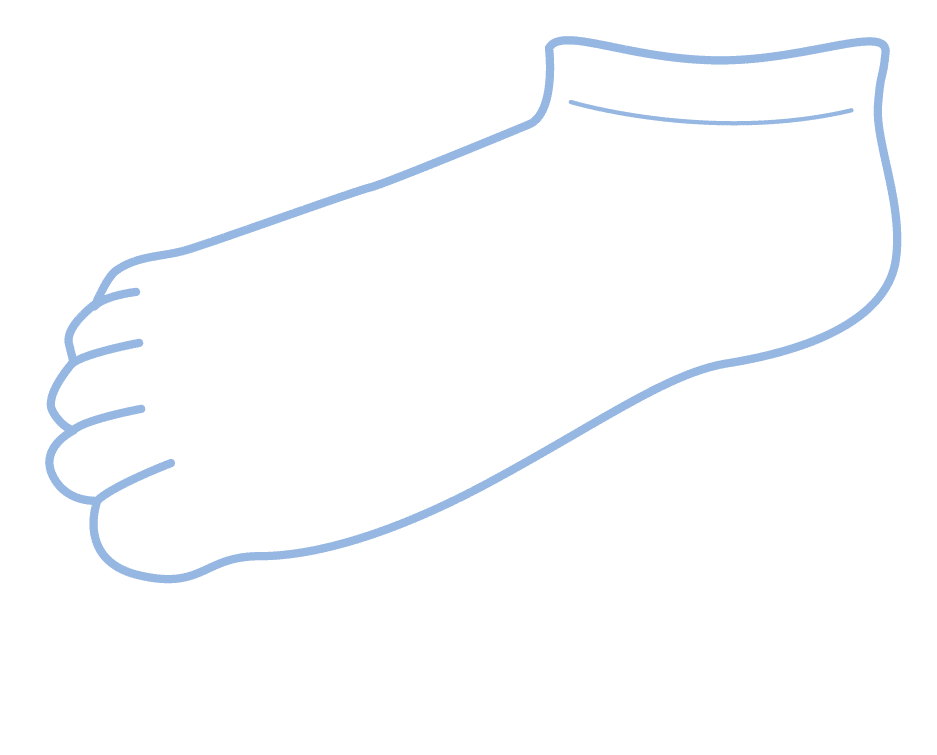
Conventional five-toed socks are woven in a straight line from the top of the foot to the tip of the toes, so they have no corrective power and do not bring the foot closer to the ideal foot.
Special non-slip fibers prevent toe deformities.
The biggest cause of flexion toes (kagayubi), is foot slippage. When the foot slips in the shoe, the toes bend down to apply the brakes. YOSHIRO SOCKS prevent bent toes by weaving in highly slip-resistant fibers.
Made in Japan with the utmost care and attention to detail, one pair at a time.
They are produced at a factory in Japan on a seamless machine called a WHOLEGARMENT® machine (SHIMA SEIKI), and each pair takes a whopping 20 minutes to sew (about 5 times longer than on a standard sock knitting machine). From finishing to packaging, inspection, and shipping, we are committed to making our products in Japan.

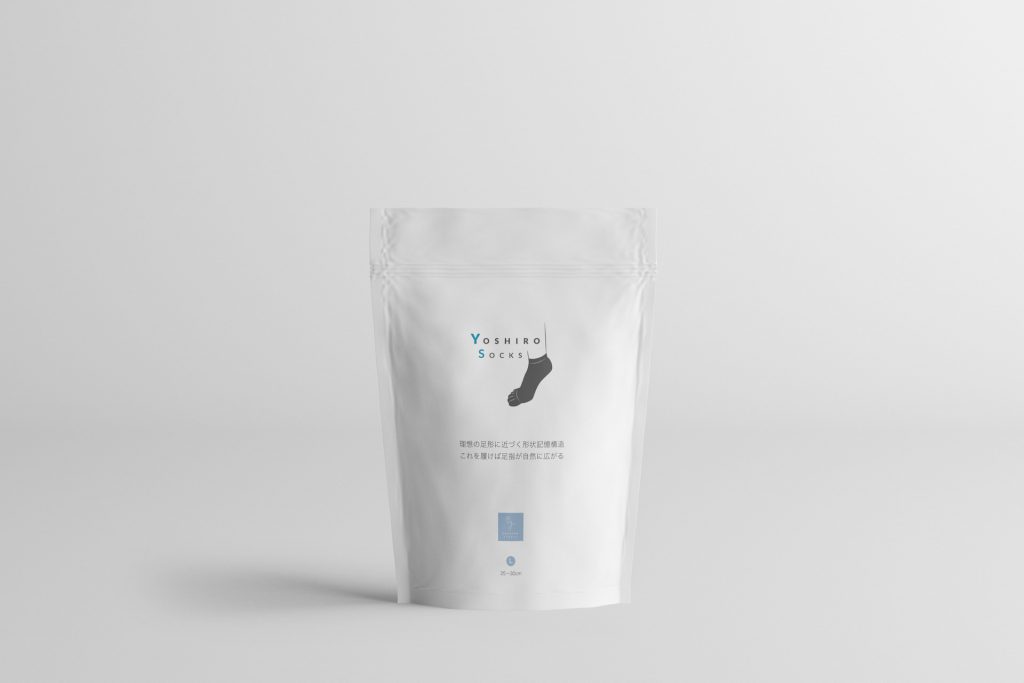
YOSHIRO SOCKS
Price: 3,850 yen (tax included)
Color: white and gray
Size: 3 sizes (S, M, L)
Video on how to put on socks
Prognosis of Flatfoot
What is the prognosis for people with flat feet?
Most people with flat feet can alleviate their symptoms with nonsurgical treatment. Some people do not need treatment. It is important to note that flat feet may increase the risk of certain problems, including
Arthritis
bone spur
Hallux valgus
Fish eyes, octopus
Back pain
Hip pain
Knee pain
Shin splints
1) American Academy of Orthopaedic Surgeons. Adult Acquired Flatfoot. (https://orthoinfo.aaos.org/en/diseases-conditions/adult-acquired-flatfoot/) Accessed 5/13/2021.
(2) American Academy of Orthopaedic Surgeons. Vertical Talus. (https://orthoinfo.aaos.org/en/diseases-conditions/vertical-talus) Accessed 5/13/2021.
3) American Academy of Pediatrics. Flat Feet and Fallen Arches. (https://www.healthychildren.org/English/health-issues/conditions/orthopedic/Pages/Flat-Feet-Fallen-Arches.aspx) Accessed 5/13/2021.
4) American College of Foot and Ankle Surgeons. Flexible Flatfoot. (https://www.foothealthfacts.org/conditions/flexible-flatfoot) Accessed 5/13/2021.
(5) National Health Service (UK). Flat Feet. (https://www.nhs.uk/conditions/flat-feet/) Accessed 5/13/2021.
6) Adult acquired flatfoot. American Academy of Orthopaedic Surgeons. https://orthoinfo.aaos.org/en/diseases-conditions/adult- acquired-flatfoot. Accessed May 22, 2022.
7) Flexible flatfoot in children. American Academy of Orthopaedic Surgeons. https://orthoinfo.aaos.org/en/diseases-conditions/ flexible-flatfoot-in-children. Accessed May 22, 2022.
(8) Fields KB. overview of foot anatomy and biomechanics and assessment of foot pain in adults. https://www.uptodate.com/contents/search. Accessed May 22, 2022.
(9) Chorley J. Forefoot and midfoot pain in the active child or skeletally immature adolescent: overview of causes. https://www.uptodate.com/contents /search. Accessed May 22, 2022.
10) Pes planus/flat foot. In: Wheeless' Textbook of Orthopaedics. https://www.wheelessonline.com/muscles-tendons/pes-planus- flat-foot. Accessed May 22, 2022.
11) Posterior tibial tendon dysfunction. American Academy of Orthopaedic Surgeons. https://orthoinfo.aaos.org/en/diseases- conditions/posterior-tibial-tendon-dysfunction. Accessed May 22, 2022.
(12) Greisberg JK, et al. eds. Flatfoot. In: Core Knowledge in Orthopaedics: Foot and Ankle. 2nd ed. Elsevier; 2019. https://www.clinicalkey.com. Accessed May 22, 2022.
13) Ryssman DB (expert opinion). Mayo Clinic. June 28, 2022.
